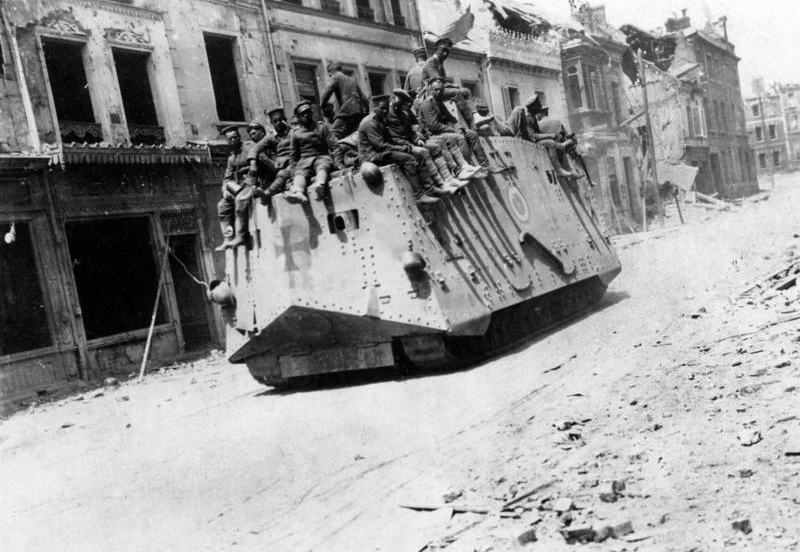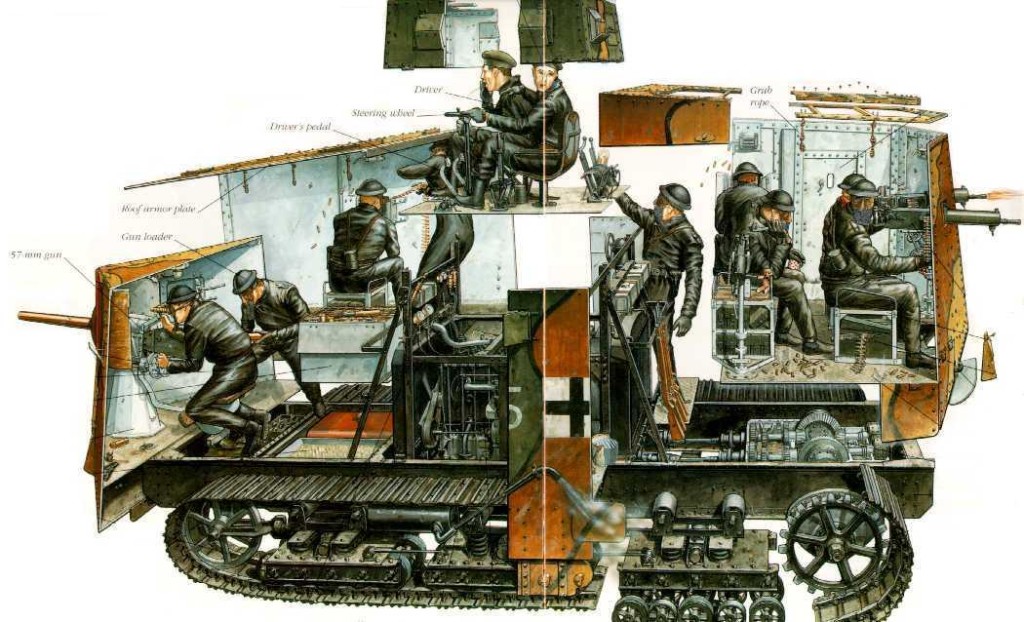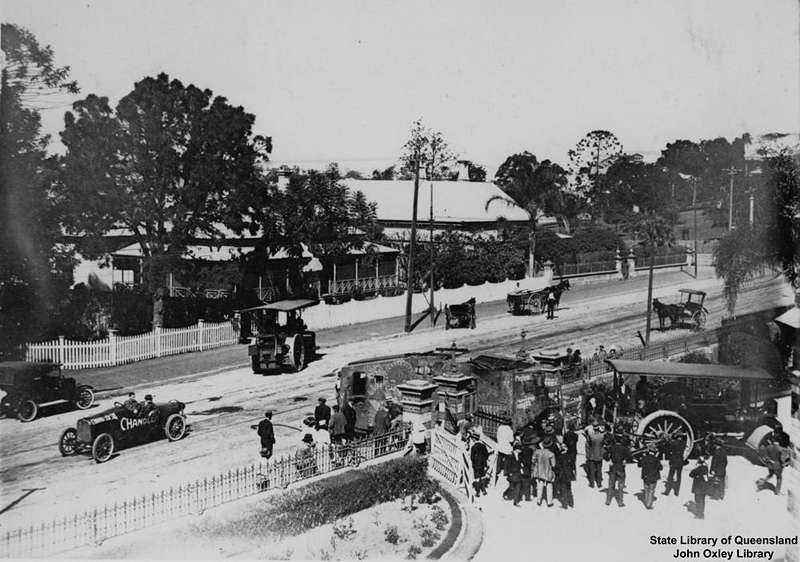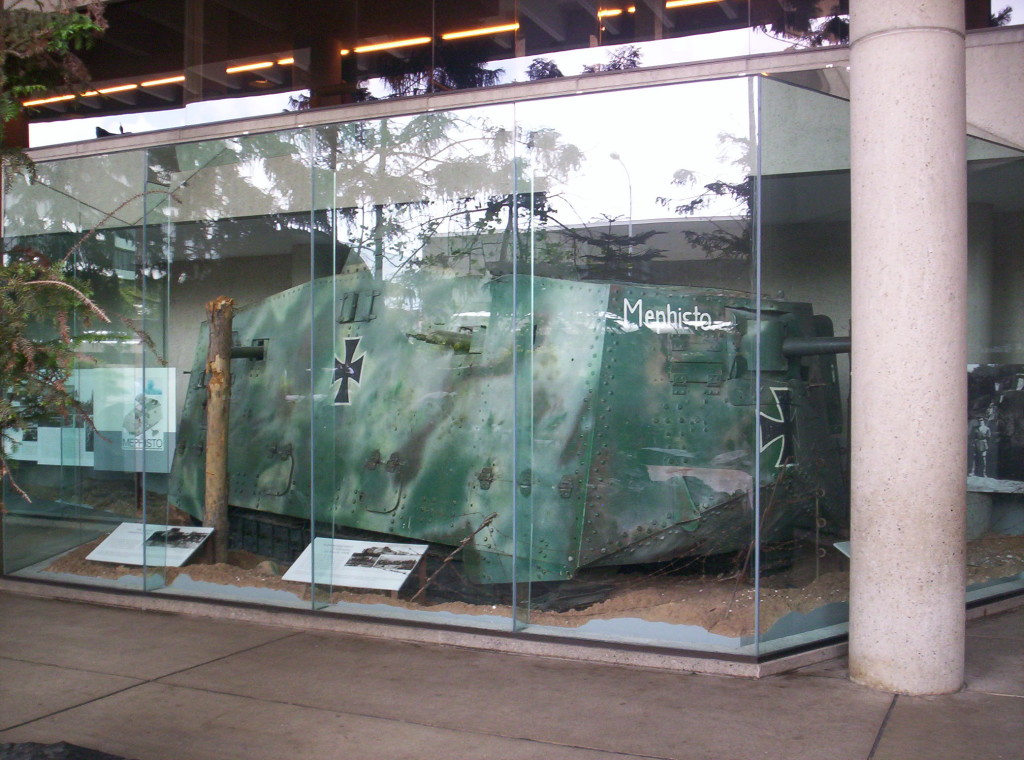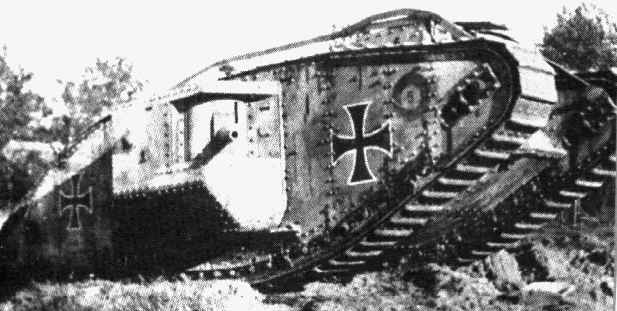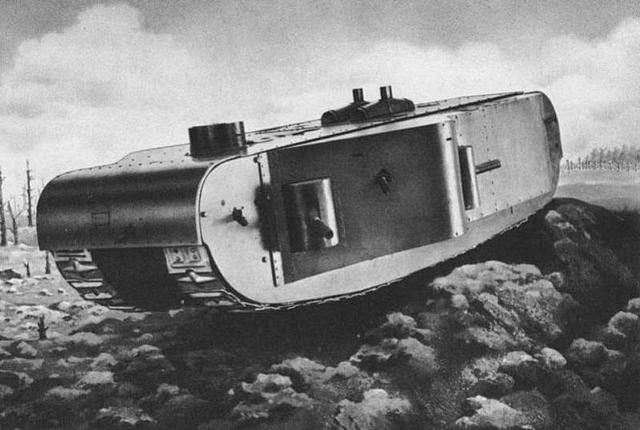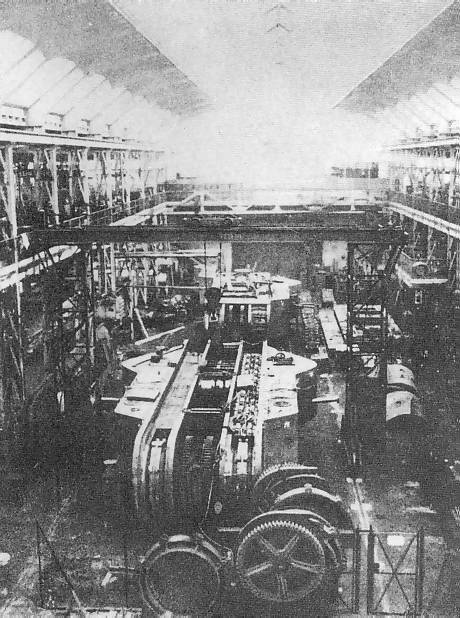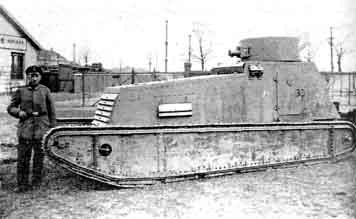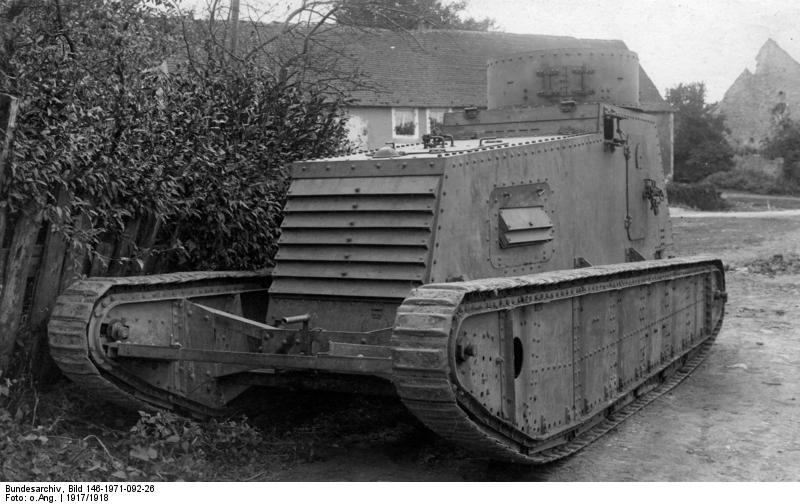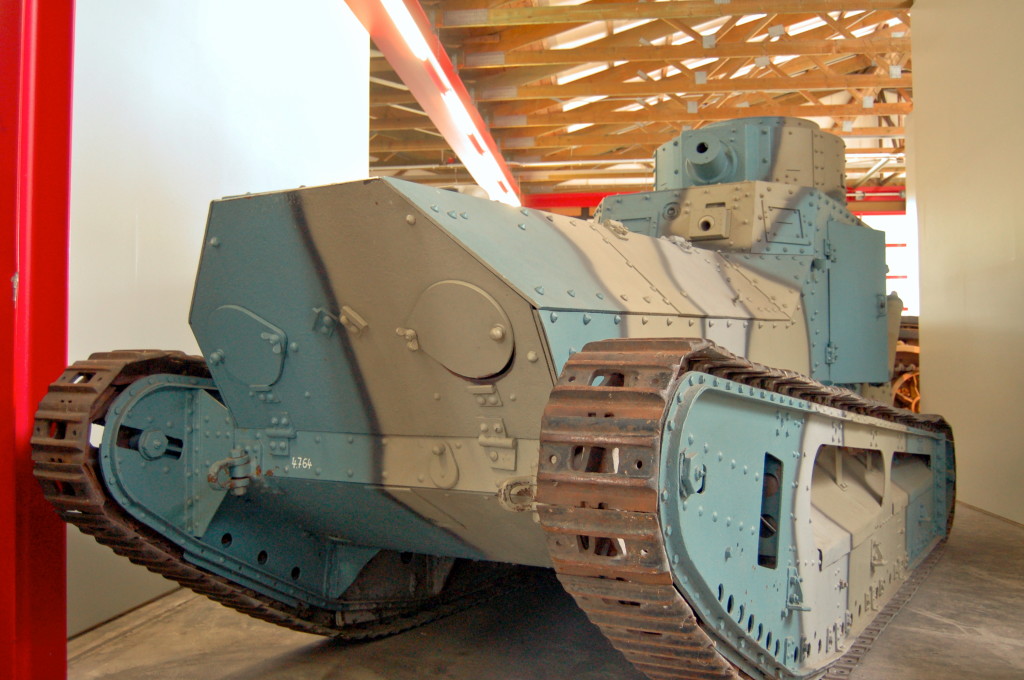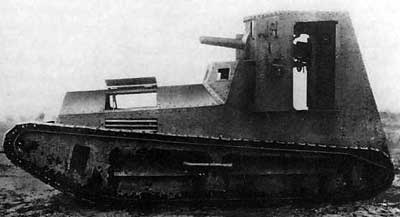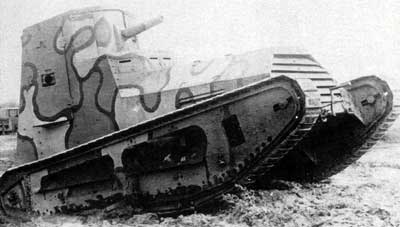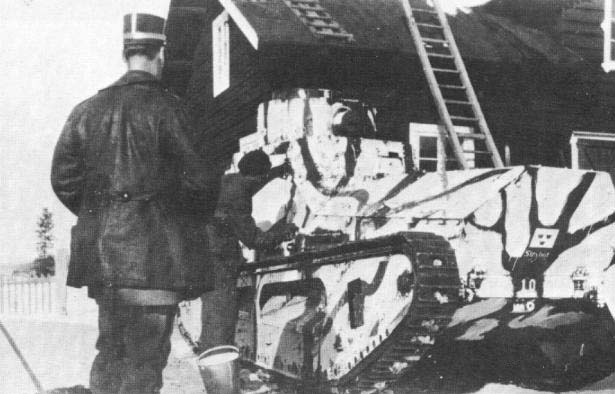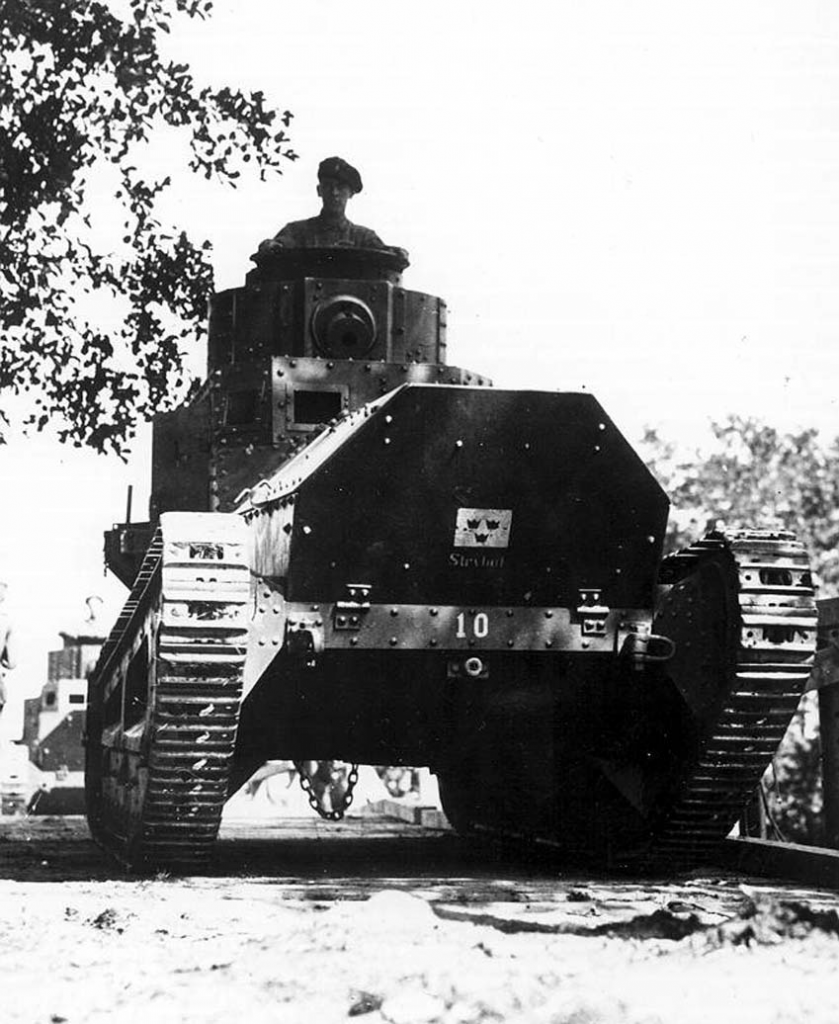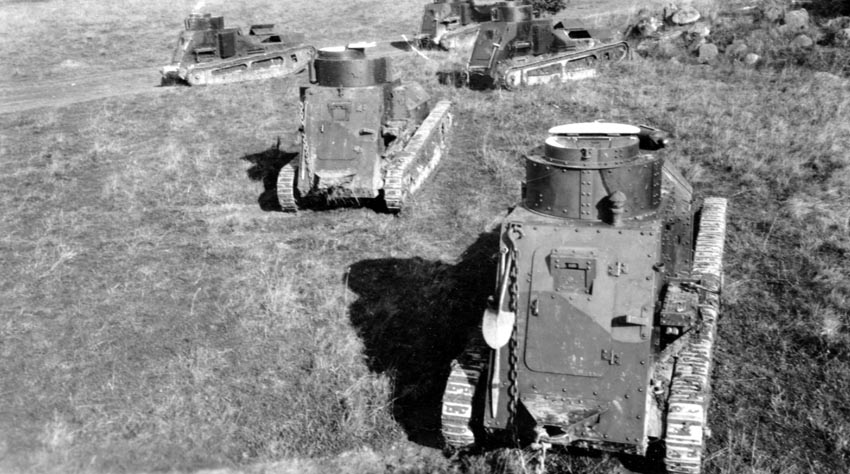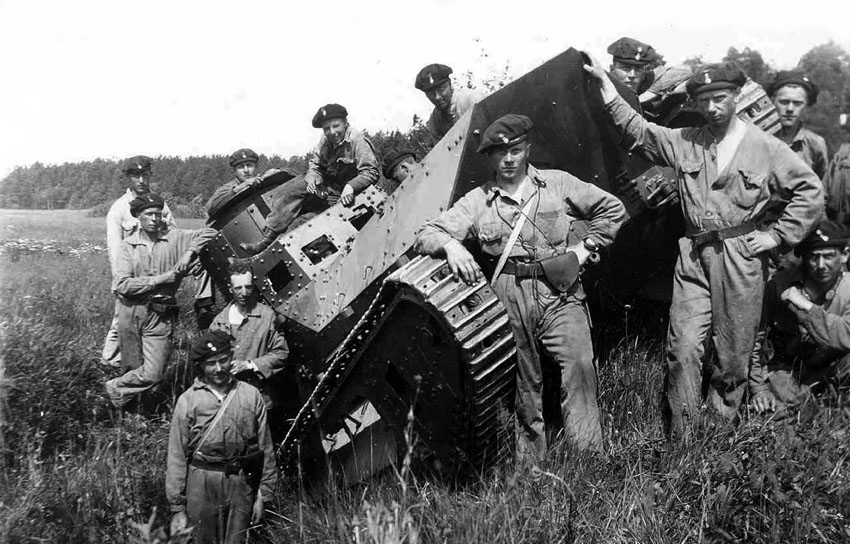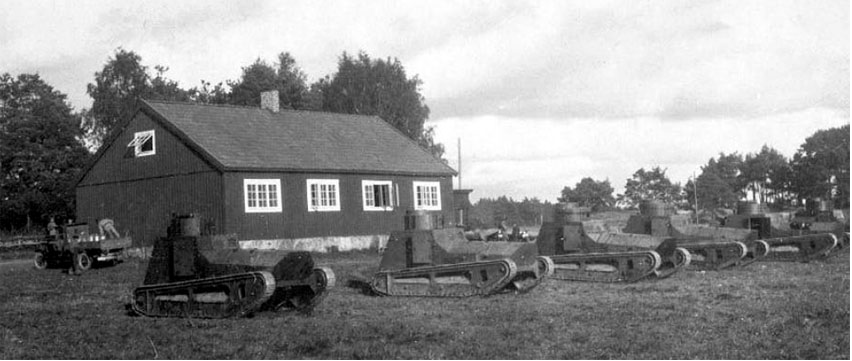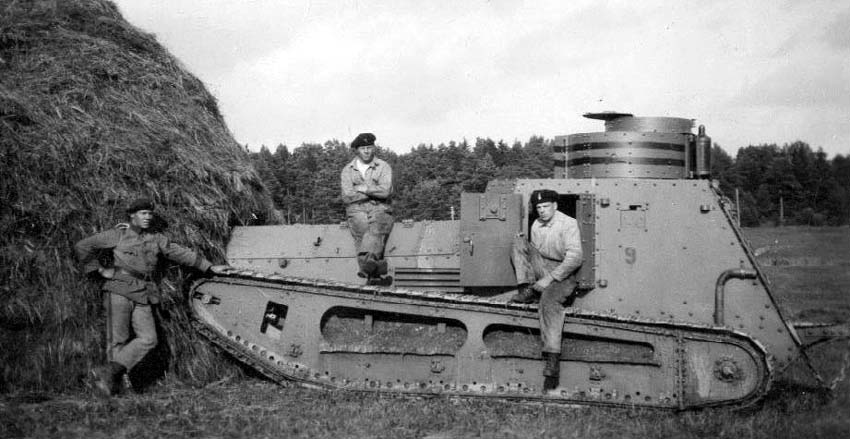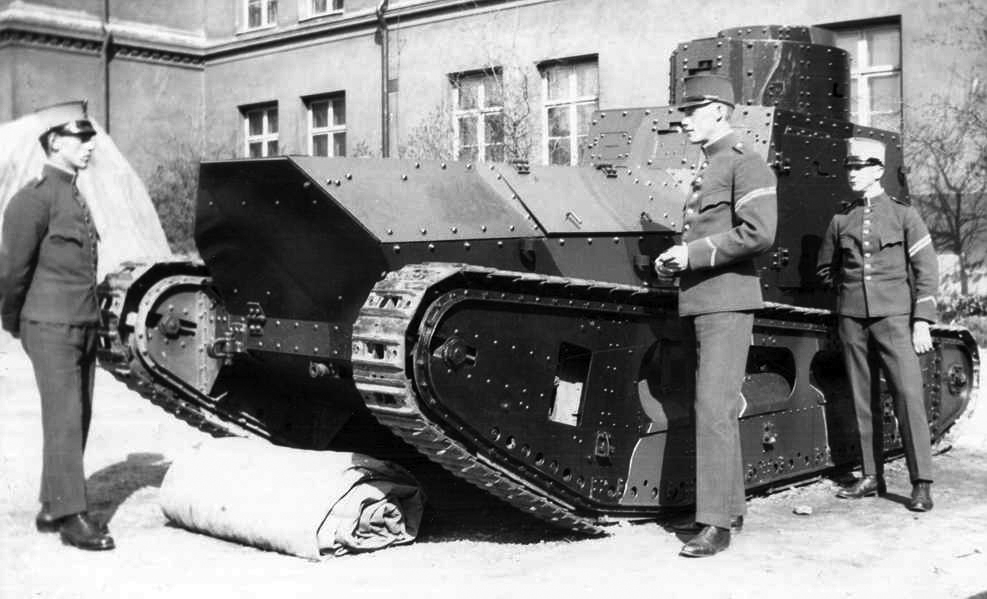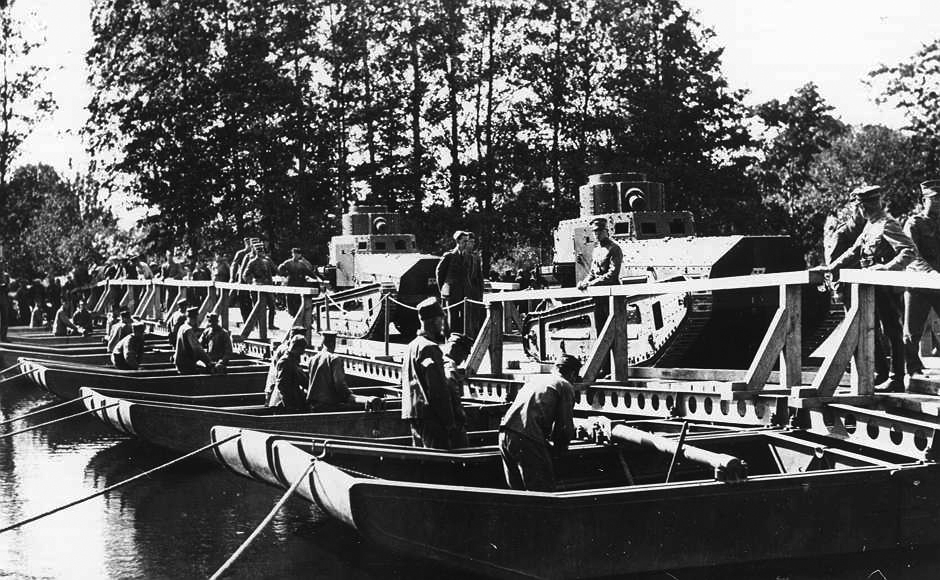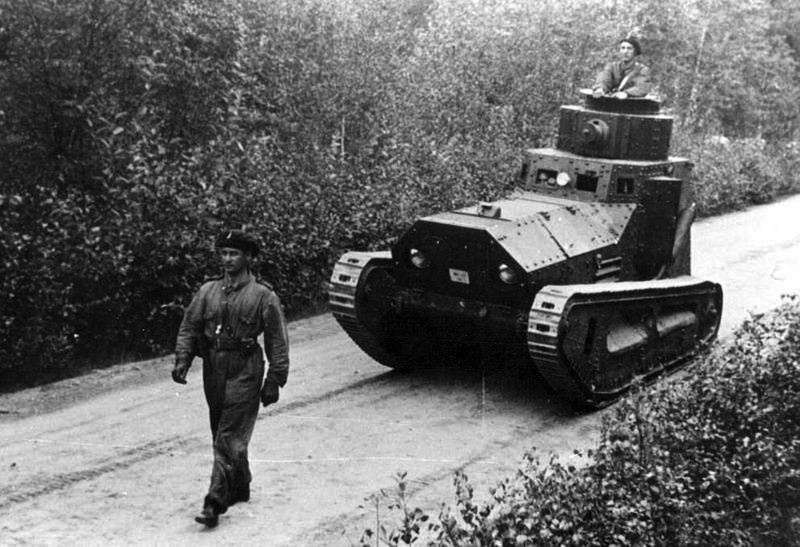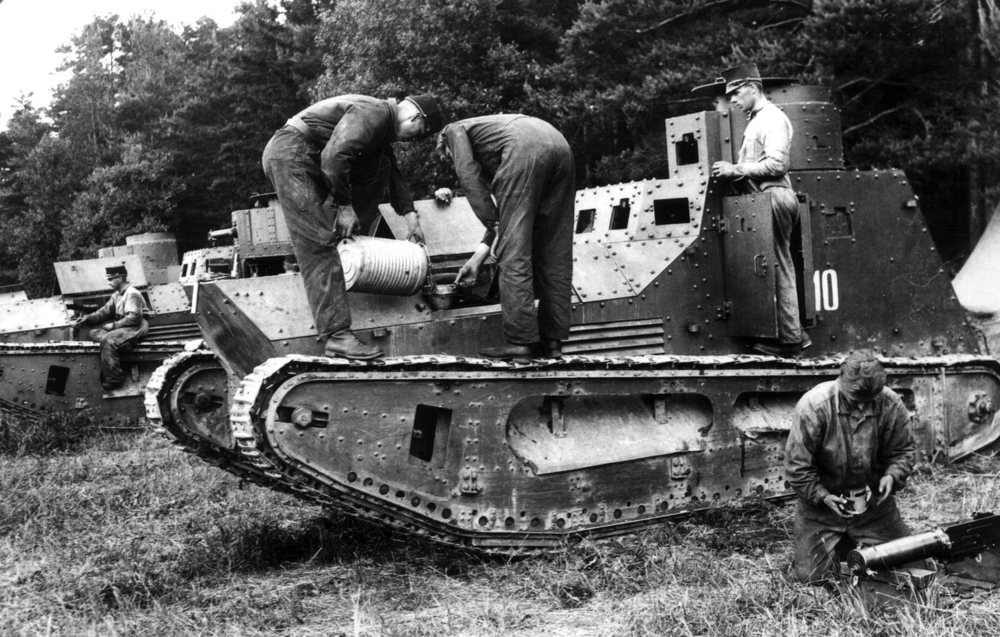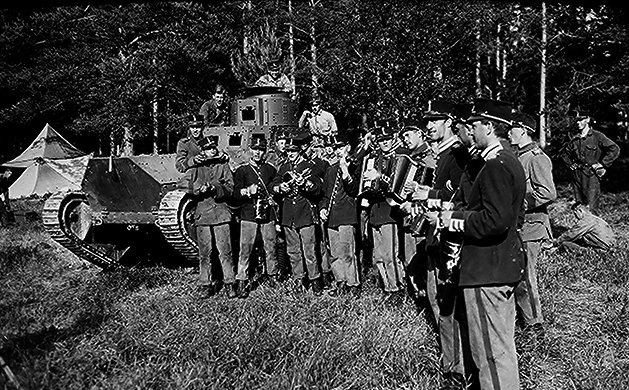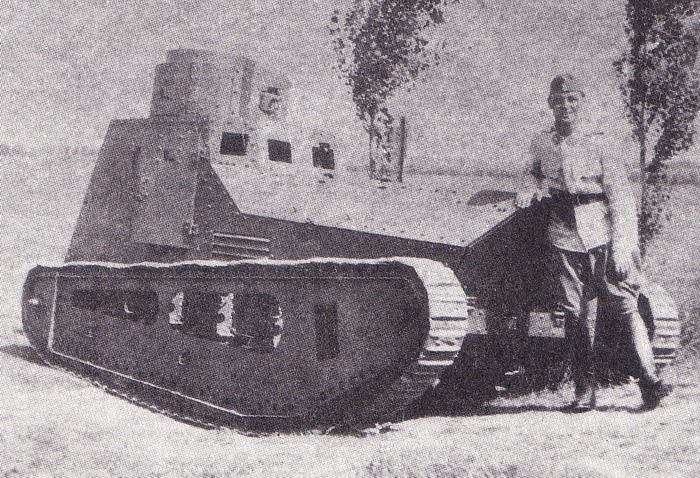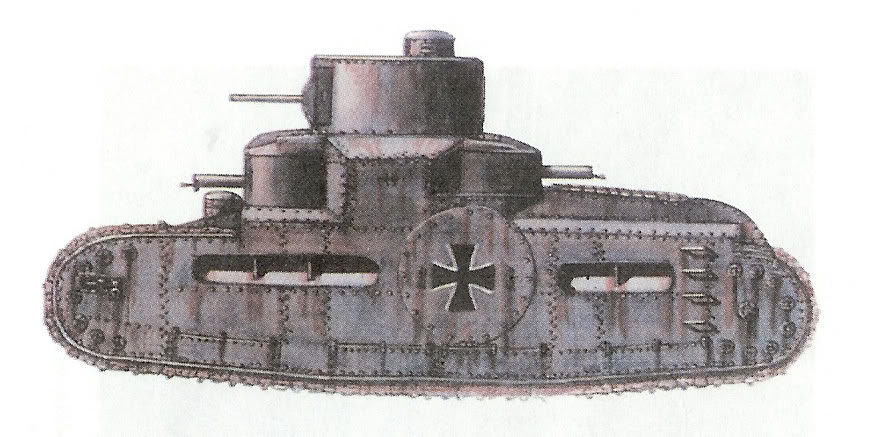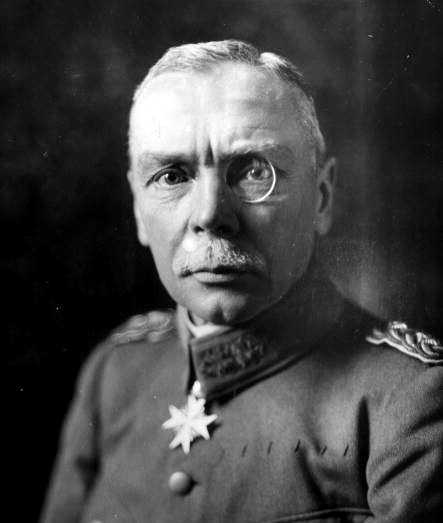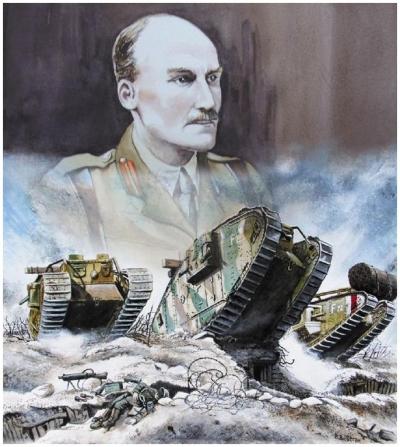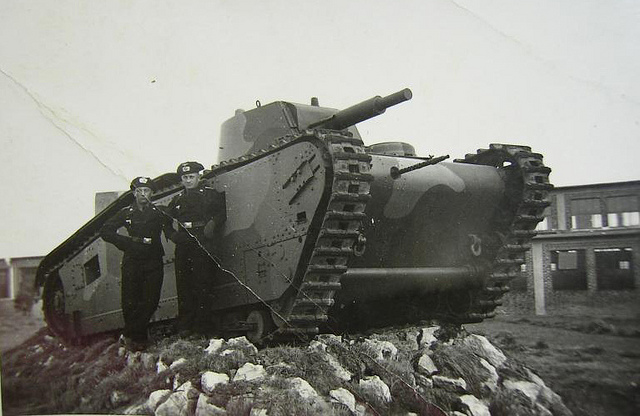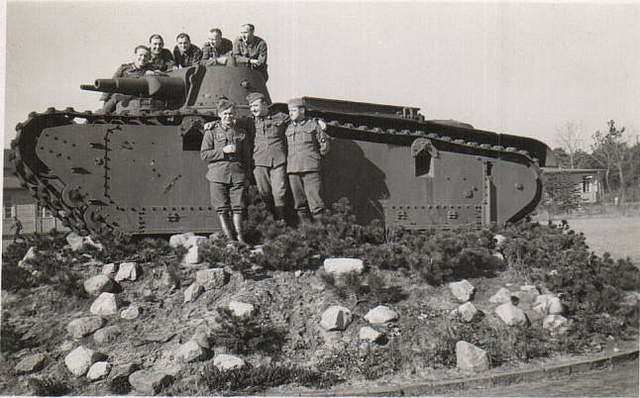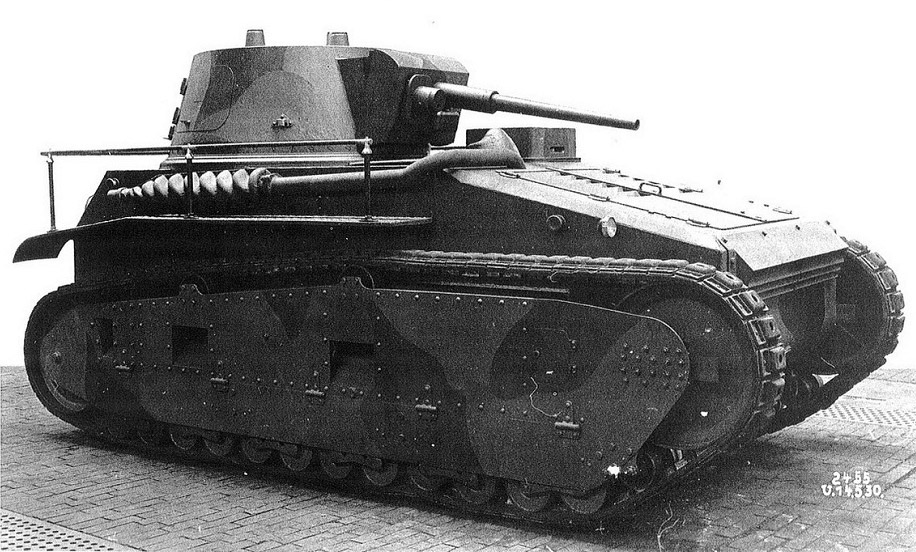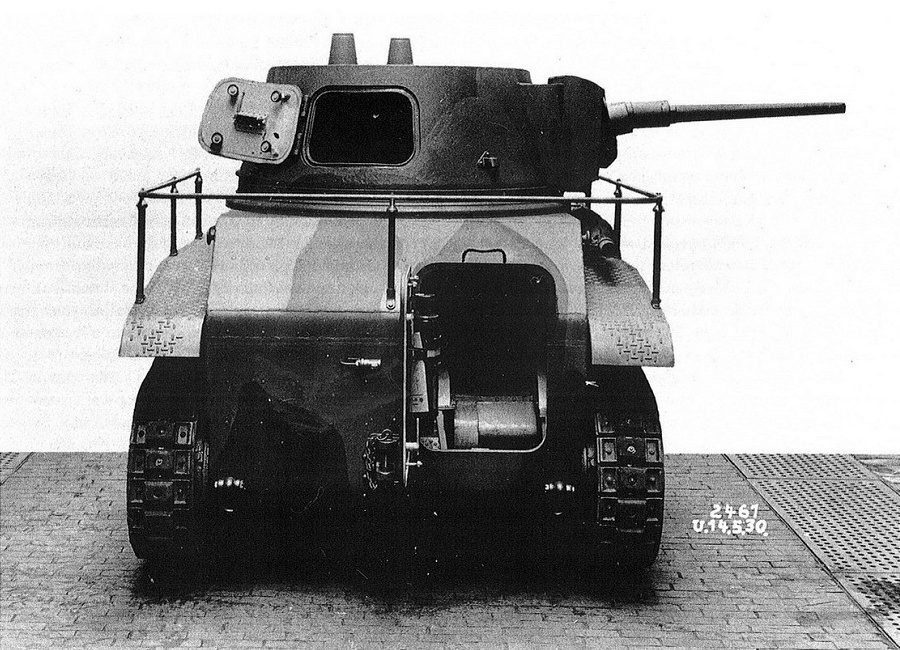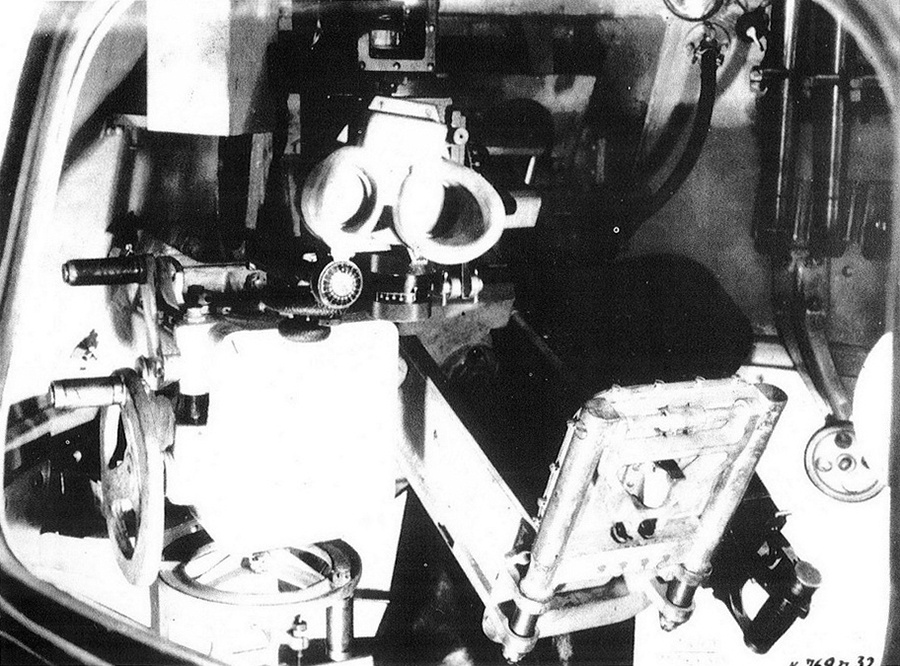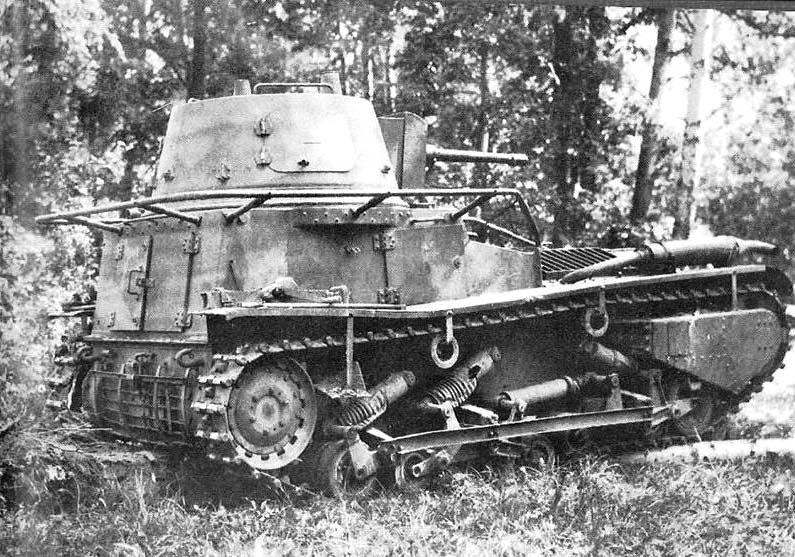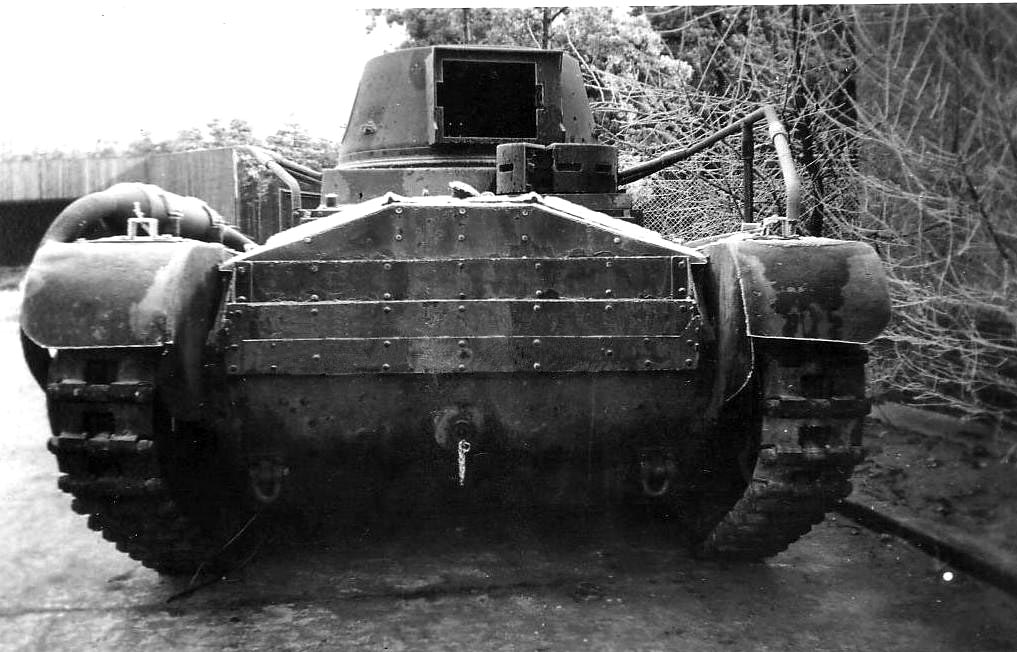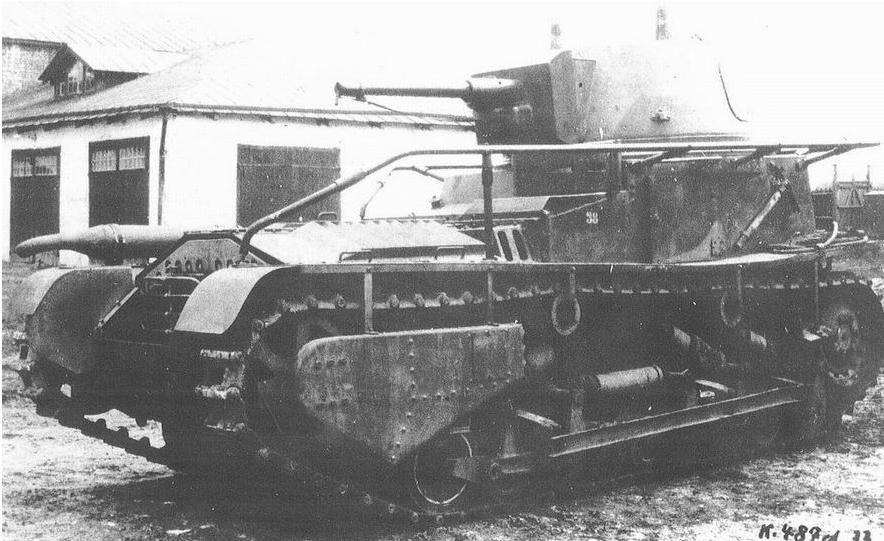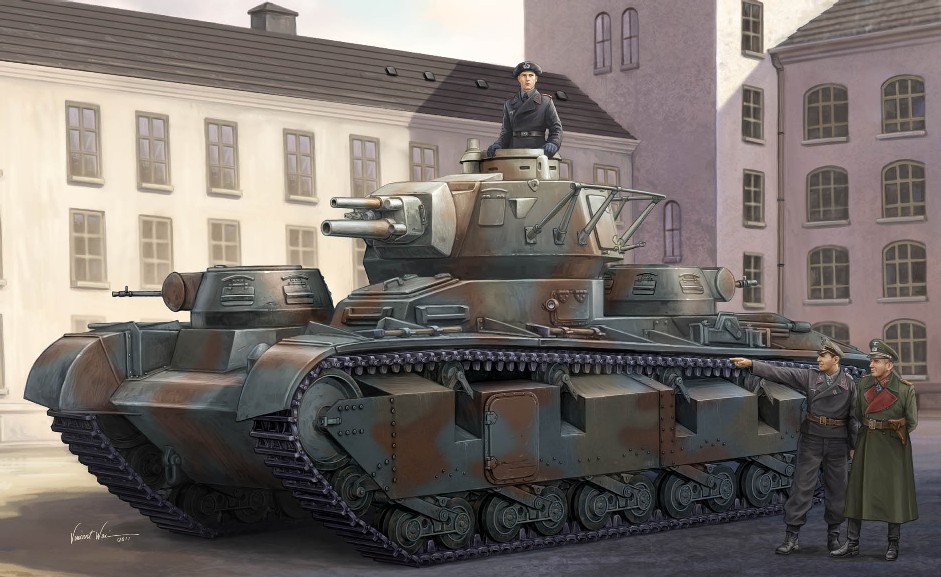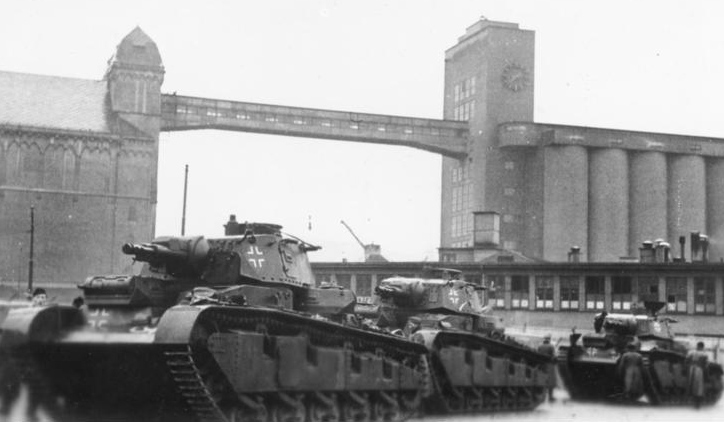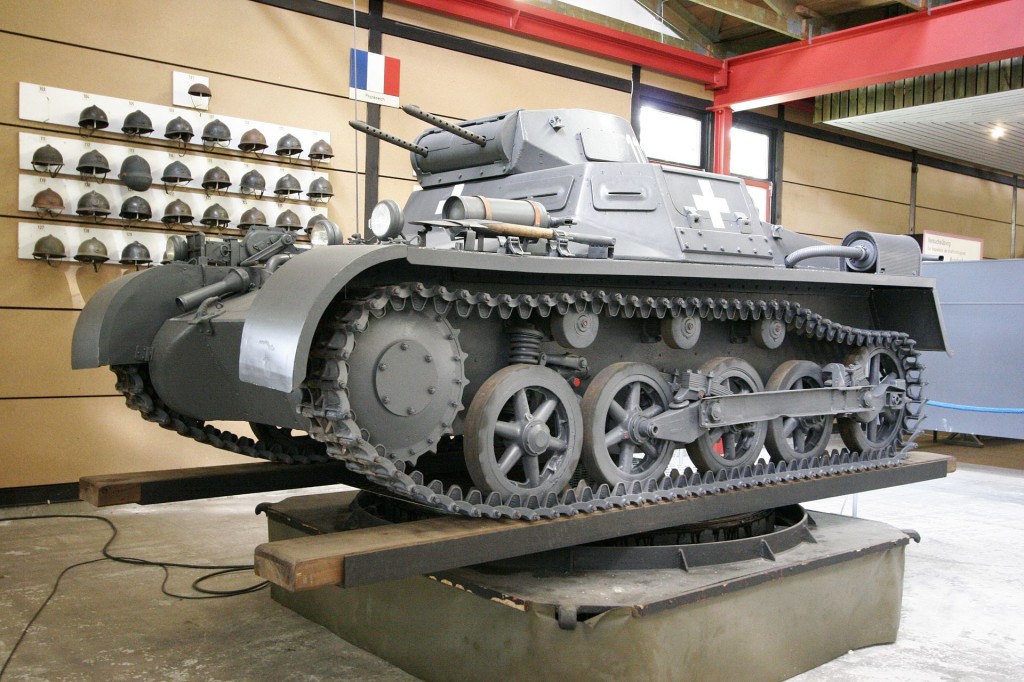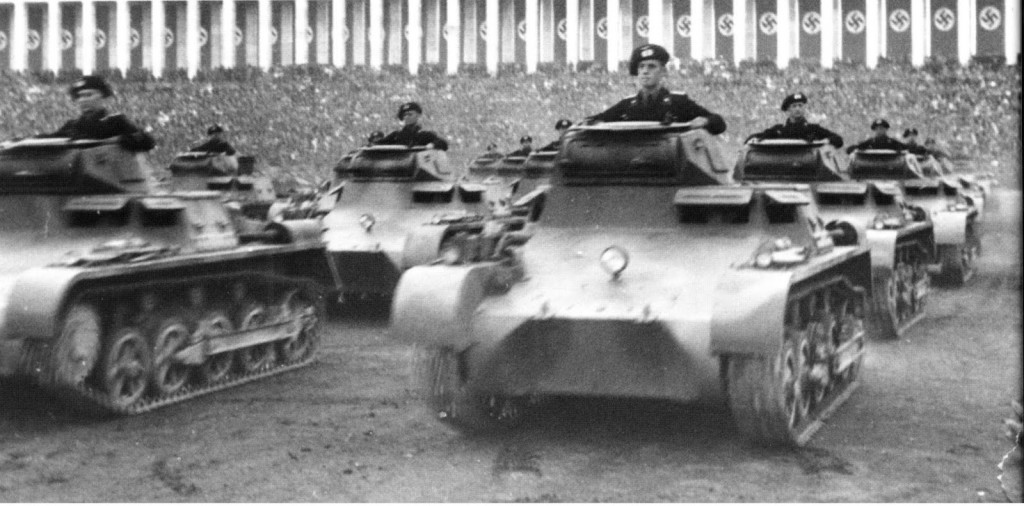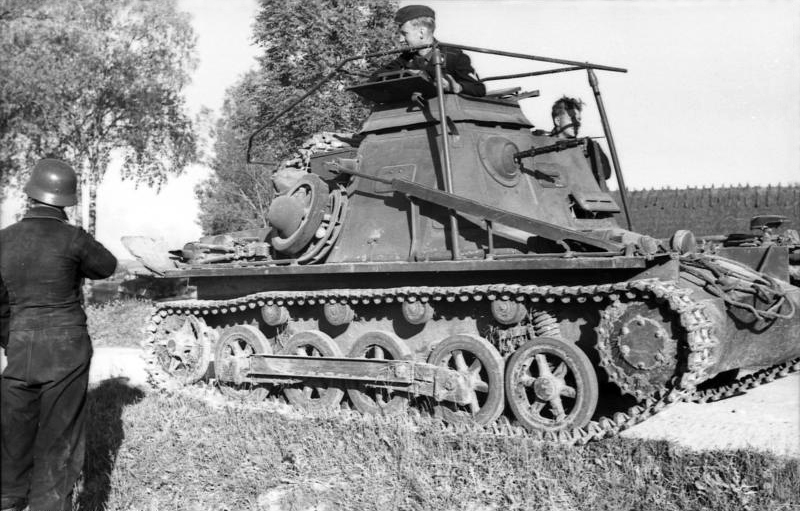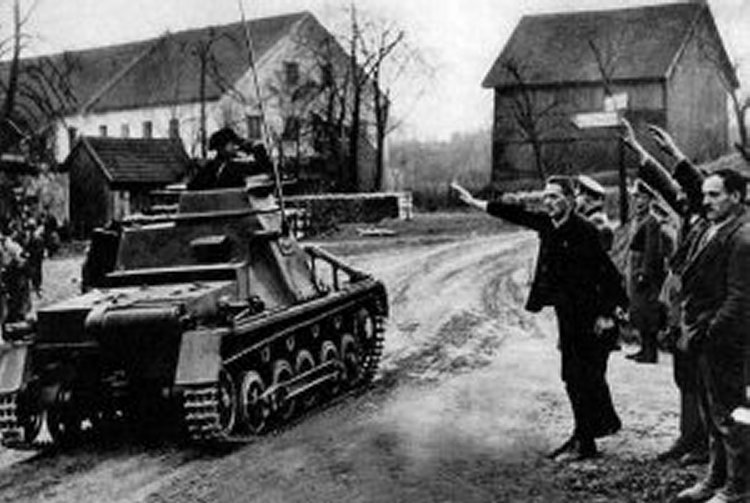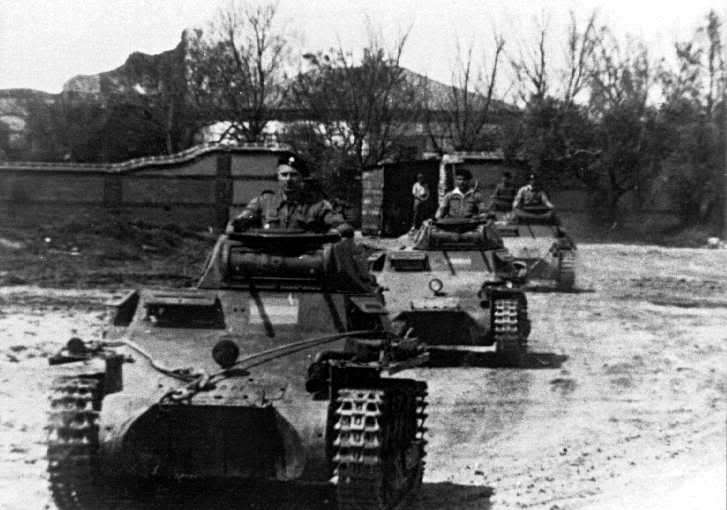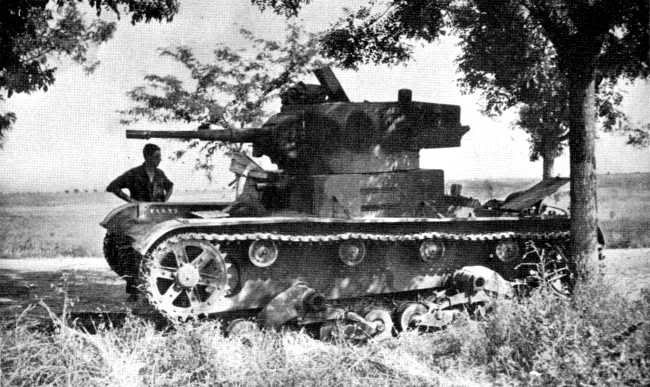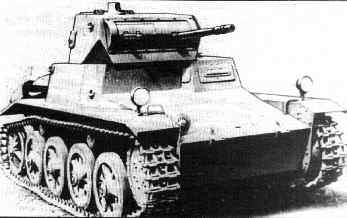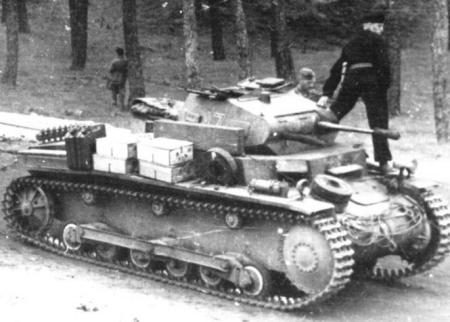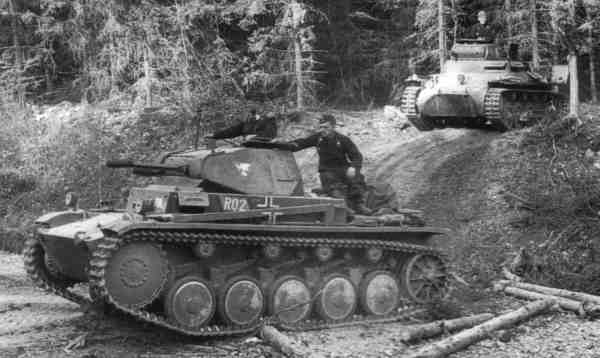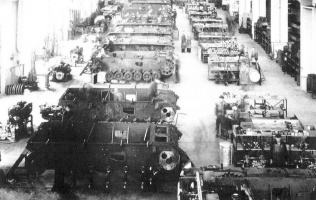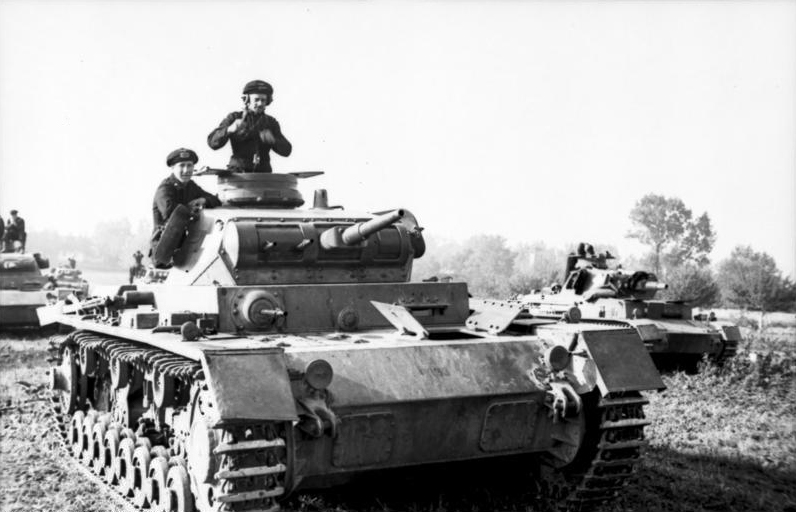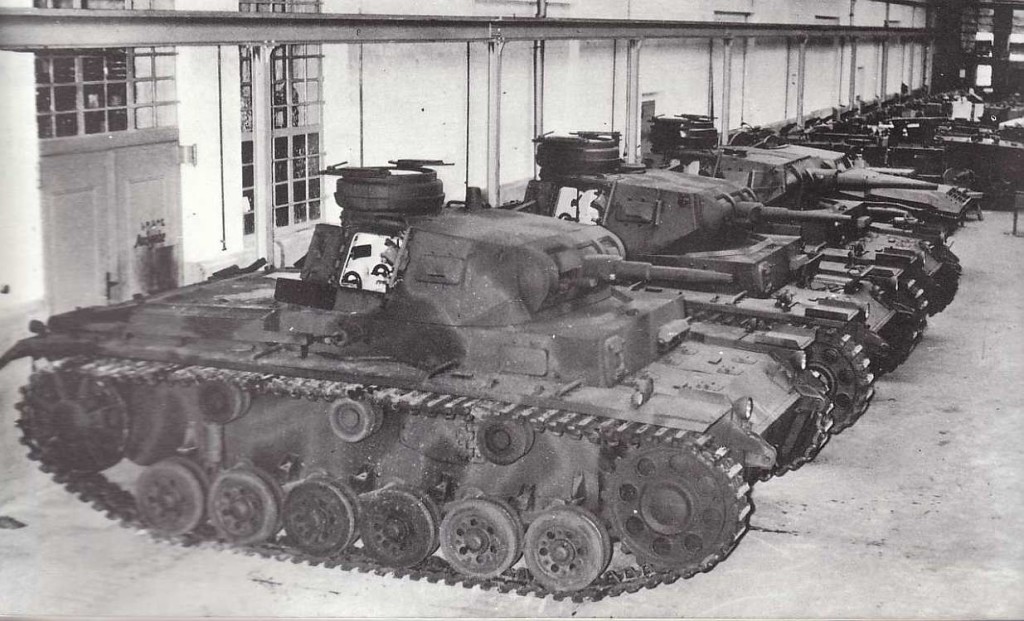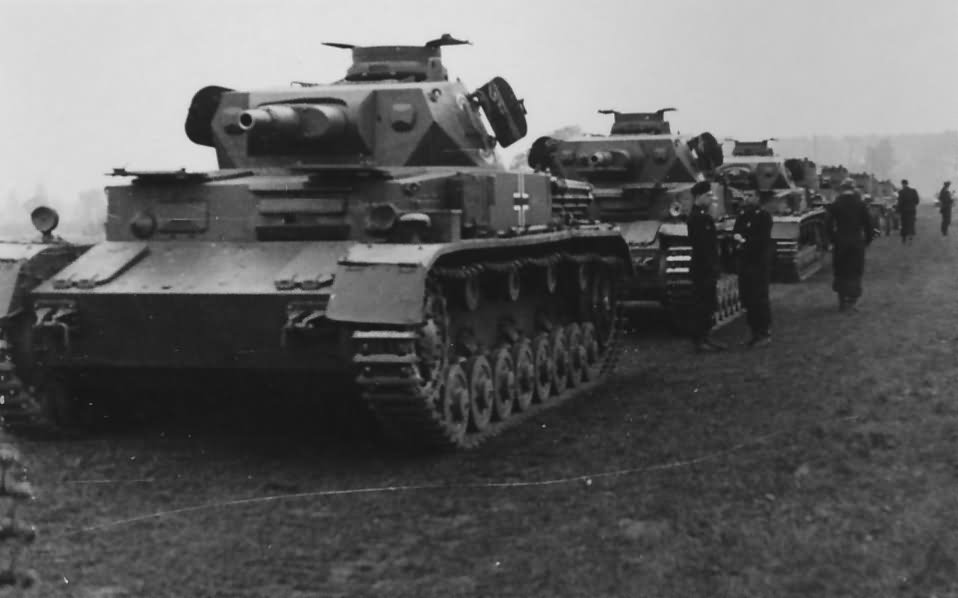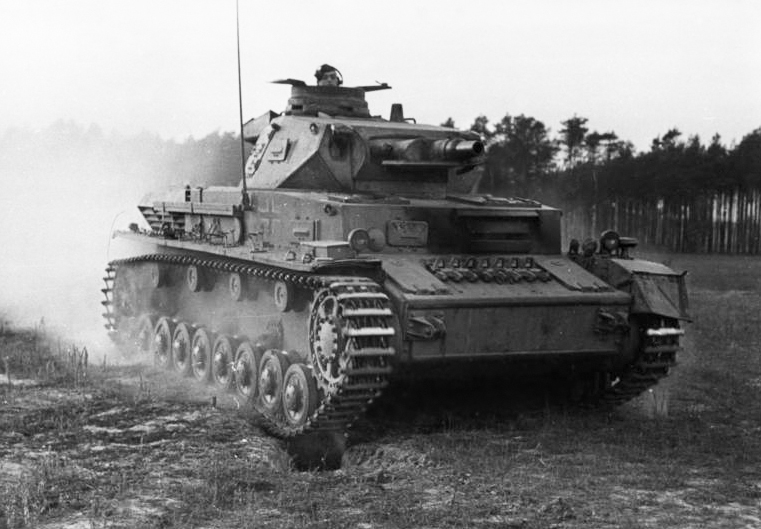The German Tanks of World War One
The development of tanks in World War I began as an attempt to break the stalemate which trench warfare had brought to the Western Front. The British and French both began experimenting in 1915, and deployed tanks in battle from 1916 and 1917 respectively. The Germans, on the other hand, were slower to develop tanks, rather they concentrated on anti-tank weapons. The initial German response to the modest initial successes of the Allied tanks was the A7V, which, like some other tanks of the period, was based on caterpillar tracks of the type found on the American Holt Tractors. Initially unconvinced that tanks were a serious threat, the High Command ordered just twenty A7Vs, which took part in a handful of actions between March and October, 1918.
The first German Tank – the A7V
The A7V is certainly a front-runner for the ugliest and least capable tank ever to have been built and gone into action. Powered by two Daimler engines, the tank was first demonstrated in the Spring Offensive of 1918. Internally, the Sturmpanzerwagen was cramped, smelly and noisy. No fewer than 18 men were called upon to man the machine to its full “potential”. With the 57 mm main gun at front, internal operators had access to two 7.92 mm machine guns at the rear along with a further four along the sides of the steel beast – two to a side. Each machine gun would need to be manned by a further two personnel per gun – a firer and an ammunition re-supplier. The engine sat in the lower-middle of the design with the main gear components resting under the rear. A crew of two would man the front 57 mm main gun, one firing whilst the other loaded the weapon. Two drivers sat in the upper center bulge area operating a steering wheel and lever controls. Stowage was allotted for individual crew weapons in the form of rifles. During final design the rear-facing cannon was removed and the number of machine-guns was increased to six. Grab ropes were provided throughout as the design had plenty of headroom space for the average soldier, though travel made for an uneasy and overall bumpy ride.
In theory, the idea of an armored box bristling with all types of deadly hardware seemed sound. In practice, however, the large design was far from perfect. The vehicle was excessively heavy, making it impractical to be used on uneven terrain. The system was slow as well, often meaning that it could be outpaced by the very infantry it was to assist. The short tracks of the tractor system also made the vehicle relatively unsafe and uncontrollable in some cases. It weighed 33 tons overall and with it’s short under-slung tracks and low ground clearance, it had almost no capability to overcome obstacles or cross broken, shell-hole filled and muddy ground – the typical terrain of the Western Front.
If the A7V has one saving grace, it was that the all-around armor protection for the crew was second to none – even when compared to the British designs – over an inch in some areas. A hundred of these tanks were ordered although only 20 were ever produced, and the first of these were ready in October 1917. There were numerous differences between individual tanks since all parts were handmade and made to fit given tank. The Schwerer Kampfwagen A7V was first used at St Quentin on 21 March 1918. Although some of its features, such as the sprung tracks and the thicker armour, made it better than British tanks at that time, the A7V was less successful as a battle vehicle. The main problems concerned its mechanical reliability and the difficulty it encountered crossing enemy trenches due to its track design and minimal ground clearance.
An original A7V captured by Australian troops in 1918 can be seen in the museum in Brisbane, Queensland in Australia. One of only 20 built, it is the last surviving example of the first German military tank and while on display, it’s not in running order.
The tank was lost at the Second Battle of Villers-Bretonneux on 24 April 1918. The battle for the area saw the Australian, British and German forces in a fluid situation, moving around the tank which had been disabled after falling into a ditch and still had dead crew inside.
The 26th Battalion of the 7th Brigade, mostly from Queensland, hatched a plan to capture it so it could not be reused by the Germans. In July 1918 after launching an artillery barrage, the Infantry moved forward and dragged it back to their lines; the Germans were still in sight of the tank and firing at them. They had to don gas masks after poison gas was deployed. The tank was then graffitied by Australian troops, with a painting of the AIF rising sun emblem. Machinations began to take the tank back to Australia, but the British wanted to keep it for the Imperial War Museum. It was quickly put on a ship destined for Sydney with the Australian infantry that captured it. The ship was supposed to deliver it to Sydney, with plans for it to go to the war memorial in Canberra’s display, but it was diverted to Brisbane and unloaded there. Two steam traction engines moved it from the ship to the museum, dragging it on its tracks.
The Queensland Museum, where it was housed, changed location a number of times, and the tank at one point was housed outside, where it was exposed to the elements, and parts were removed from it by the public. After many years it was eventually moved inside the museum and put behind glass in a temperature controlled environment, protecting it from the public. Following the 2011 Brisbane Floods, Mephisto was removed from the Queensland Museum to an undisclosed location for restoration work. It was claimed that the vehicle would be returned to the museum during 2012. However, in March 2013 it was revealed that the vehicle was temporarily housed at the Workshops Rail Museum at North Ipswich where it was placed on temporary display. It will return to the Queensland Museum in 2015.
The A7V’s suffered from numerous design faults and already towards the end of the First World War it was clear that the A7V was a failure, being too slow and clumsy in action and slow to build. Germany actually used more captured British tanks than A7Vs.
In fact, most “German” tanks in service over 1917-1918 were British tanks captured at Cambrai and other locations. Some 100 of these were repaired, overhauled at Charleroi (by Bavarian Army Motor Vehicle Park 20) and rearmed with Russian 57mm Sokol / Belgian 57mm Maxim Nordenfeld guns in place of British 6pdr guns (Male tanks) and 7.92mm Maxim 08 machine guns (Female tanks). Spare parts were obtained from battle damaged tanks unfit for repair. Captured tanks were grouped in four captured tank companies – Sturmpanzerwagenabteilungen (Beute). Captured British Mark A Whippets also equipped an entire German captured tank company and some French tanks (including Renault FT-17 light tanks) captured during the German offensive in November of 1918 were also used.
The K-Wagen
As it became clear that the tank could play a significant role on the battlefield, Germany began working on designs for both heavy and light tanks. And when they designed a “heavy” tank, they meant “heavy”. In WW1, anticipating the outrageously super-heavy tank designs of WW2, German designers came up with the K-wagen, designed by Joseph Vollmer, a reserve captain and engineer working for the Verkehrstechnische Prüfungskommission (“Transport-technologies Board of Examiners” of the army) and a Captain Weger (Wegner?). On June 28 1917 the War Ministry approved the draft design and in December 1917 ordered ten examples built, five to be built by the Riebe ball-bearing factory in Berlin and five by Wegman and Co. of Kassel.
The vehicle originally weighed 165 tons but this was reduced to a more practicable 120 tons by shortening the length. The huge size and mass of the K-Wagen made it impossible to transport, so it was decided that it would be split into sections for transport by rail, to be reassembled behind the front line near where it was to be used.
The hull of the K-Wagen consisted of six modules that could be transported separately by rail: the control room, the fighting room, the engine room, the transmission room and the two sponsons. Modified U-Boot communications and control equipment was to be used. The commander gave orders to the crew by means of electric lights: fire control was comparable to that of a destroyer, the Germans seeing the vehicle as a veritable “landship”. The drivers would have had to steer the vehicle blindly, directed by the commander.
The first of these K-Wagen tanks were planned to enter service in 1919. The hull was boxy and mounted with sponsons. Armor protection ranged from 10 to 30mm and the entire tank weighted 148-150 tons. The vehicle was to be 12.7m long, 3.0m wide (6.0m wide with sponsons) and 3.0m high. It featured roller-type tracks and was powered by two Daimler-Benz 6 cylinder aircraft engines (each producing 650hp) with electric-magnetic clutch transmission. Maximum speed was 7.5km/h. K-Wagen’s armament consisted of four 77mm guns (two mounted in each sponson) with 800 rounds of ammunition and seven 7.92mm Maxim 08/15 machine guns with 21,000 rounds of ammunition.
At the beginning of the project the incorporation of flamethrowers was considered but later rejected. It was to be operated by the crew of 22 men. Production was delayed, because of material shortages and only two were under construction in November of 1918 at the Riebe-Kugellager factory at Berlin. One of the tanks, “Ribe”, was complete at the end of the war, but it never left the factory. Both were eventually scrapped by the Allied Control Commission.
It was also decided that lighter tanks were required which could spearhead assaults and which could be mass-produced. A number of different types were designed and a small number of prototypes were under construction at the end of the war.
The Leichte Kampfwagen (Light Cavalry Tank) LK.I
The LK.I was designed by Joseph Vollmer (he of the K-wagen) and was influenced by the captured British Mark A Whippet Medium Tanks. It was based on a Daimler car chassis, using the existing axles for sprocket and idler wheels. It’s design followed a typical automobile layout, with the engine at the front and the driving compartment in the rear. It was the first German tank to be mounted with a turret (rear mounted) armed with a 7.92mm Maxim 08/15 machine gun.
Armor protection was 8 to 14mm and entire tank weighted 6.89 tons. It was 5.08m long, 1.95m wide and 2.52m high. The LK.I was powered by single Daimler-Benz Otto Model 1910 4-cylinder 50-60hp gasoline engine with an operational range of 70km and a maximum speed of 14 km/h. It carried 140 litres of gasoline and was operated by a 3 man crew. Only (2?) prototypes were produced in mid-1918, while 800 were ordered. A prototype of the LK.I was demonstrated in Berlin in early 1918 but was seen as being underpowered.
The Leichte Kampfwagen (Light Cavalry Tank) LK.II
The LK.II was a further development of the LK.I and had the same layout as the LK.I. Instead of a rear mounted turret, it was mounted with a superstructure (barbette) armed with a 37mm Krupp or Russian 57mm Sokol gun. Armor protection was 8 to 14mm and its weight increased to 8.75 tons. It was also powered by single Daimler-Benz Otto Model 1910 4-cylinder 55-60hp gasoline engine was operated by 3 men crew. Maximum speed was 14 to 18km/h with range of 65-70km.It was 5.06 meters long, 1.95 meters wide and 2.52 meters high. Another version was planned armed with one or two 7.92mm Maxim 08/15 machine guns mounted in a rear mounted turret but this remained as a design only.
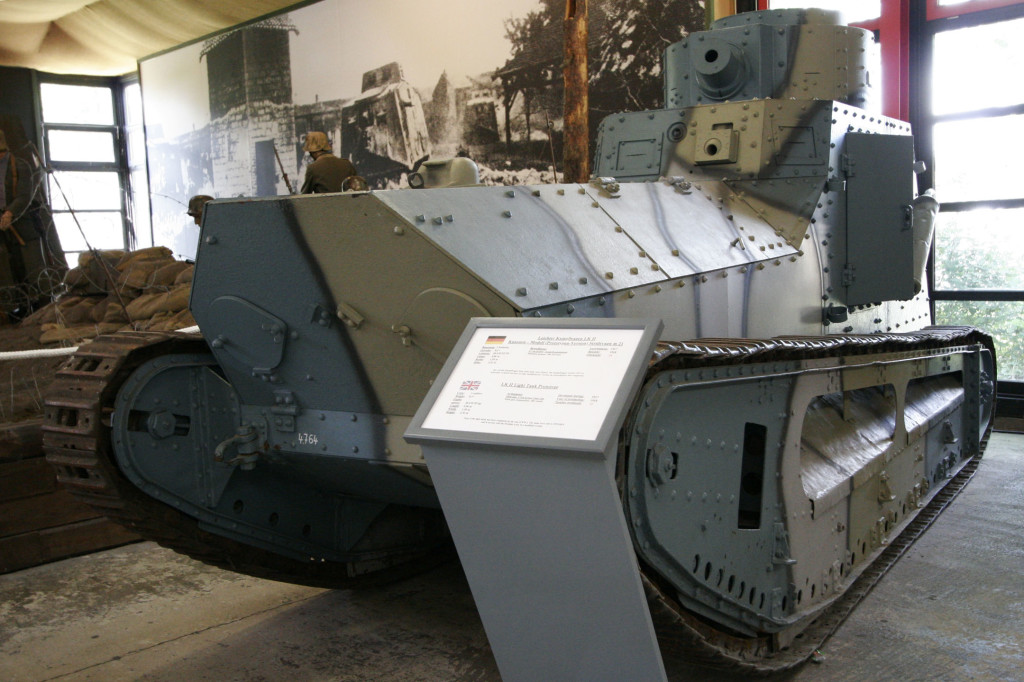
A WW1 German Leichte Kampfwagen LK II light Tank can be found at the Deutsches Panzermuseum in the small military town of Munster, Germany
Two prototypes of the LK II were produced in June of 1918 and both the LK.I and the LK.II were demonstrated on June 13. Both projects were recommended for further development of a machine-gun version with a rotating turret. After the Battle of Amiens began, Krupp (although they did not have ready yet a real model) received an urgent order for 65 tanks. On October 2 1918, chassis testing of competing machines was carried out at Marienfelde. As a result the “Krupp” order for the LK.I was canceled. The choice fell on the LK-II. It was planned to producethe first 10 LK.II tanks in December 1918, and in April 1919 this number was to increase to 200 per month. Only a third of the tanks had to be machine-gun-equipped, the remaining two-thirds would be armed with cannon.
In the LK.II, the contours of the hull have changed somewhat from the LK.I. Slanted “cheekbones” are apparent on the engine covering, between the straight sides and the flat roof. Behind the engine compartment and hull are a driver’s compartment with three viwwing ports. The fixed turret had straight sides and a sloping rear wall. In the fixed turret were the gunner and loader, working in a standing position. Hatches were placed as in the LK-I, but the size was increased. In the roof of the cabin was a hatch with a hinged lid, which served for viewing and ventilation. On the straight sides, the front plate and the roof of the engine compartment were blinds with inclined upper sheets – these were armoured covers with hinged lids for easier engine maintenance.
The 37 mm gun was mounted on a vertical support. The design of the gun shield as a whole was similar to the 57-mm gun installed on the A7V tank. The Gun Mount weighed 500 kg and was supplied with a telescopic sight and handwheel traverse. The horizontal aiming angle was ± 30 °. The side door openings were provided with a port for firing an MG.08 / 15 machinegun. Otto engines were to have been of two types – either 40 or 50 hp. Starting the engine could be performed from inside or outside of the tank using a crank handle or an electric starter. Two gas tank with a total capacity of 170 liters were placed on either side of the engine, between the engine and the sides, the tank bottom was 8-mm armor. Gasoline flow was made under pressure from the exhaust gases. For reliable engine power at all inclinations of the machine a float chamber was used. To prevent flooding of the engine oil circulation system. a closed lubrication oil tank was used. Radiator cooling was by a fan. Air was sucked out and ejected through the vents in the sides and roof of the engine compartment. The exhaust pipe was on the left side.
LK.II Transmission included: a plate clutch (main clutch); 4-speed car-type gearbox; drive shaft with bevel gears, cam or disc clutch drum or band brakes; two transverse half-line with the drive bevel gear at one end and on the other the cylinder. To increase traction and the capability to climb steep slopes the drive train intermediate transmission speed was lowered in 2,14-2,16 times. When off, the intermediate transmission speed was from 3.5 to 14 km / h when activated – of 1.6 to 6.5 km / h.
Steering was via manipulation of the caterpillar tracks using a rocker arm with three positions. The driver could adjust the turning radius. The minimum turning radius was 1.7 m. The transmission was under the floor of the fighting compartment. The layout of the transmission mechanism is consistent with the small width of the tank. The ventilation system ensured that the temperature of the air inside the tank remained slightly above the surrounding atmosphere.
The estimated cost of construction for the LK-II was 65,000-70,000 DM in 1918 prices. In 1917, an order was prepared for 1,000 tanks, but for his performance did not come from, although the troops during 1918 there were demands for more mobile tanks light type. The first LK-II was built only in the autumn of 1918. Only in October 1918 was J. Vollmer was able to deliver two light tanks, which were finished with the extensive use of automotive components and assemblies – this was much more promising in terms of speed of production and was 10 times cheaper. The massive use of light LK-II type tanks would have a much greater success than heavy, but their construction was limited to a few prototypes.
After the war, the German company manufacturing the tanks hid the parts from the Allied Control Commission. In early 1919, Germany made an agreement with Hungary, for whom they secretly built 14 LK-II tanks (see more on these LK.II’s exported to Hungary and their fate below). Another batch of LK-II tanks was build for Sweden. The deal was made by the Steffen & Heyman company. Sweden also received German specialists to help with assembly. The Swedish government secretly purchased the parts for the 10 tanks for 100,000 (or 200,000, the amount is uncertain) Swedish Kronas and shipped the parts to Sweden labelled as boiler plates and agricultural equipment. The tanks were then assembled in Sweden as the Stridsvagn m/21, which was essentially an improved version of the LK.II prototype.
The Stridsvagn m/21 was armed with a single 6.5mm machine gun. In August 1922 trials began at Svea Livgarde in Stockholm. The tanks were painted army grey in and out. The engine was started by hand cranking which could also be done from the fighting compartment. External lighting was an acetylene gas light. In the autumn of 1923 five tanks participated successfully in a large manoeuvre. The trials continued from 1924 to 1927. The main objective was cross country mobility, but also armament and communication.
In 1929, five m/21’s were rebuilt as the Strv m/21-29 variant, armed with a 37mm gun or two machine guns and powered by a more powerful Scania-Vabis engine. Modifications also included heavier armour. One of these Stridsvagn m/21-29’s was driven by Heinz Guderian during a visit to Sweden in 1929. The Stridsvagn m/21-21 remained in service with the Swedish Army until 1938 and today a single example can be seen at the Deutsches Panzermuseum at Munster, Germany. Both a Stridsvagn m/21 and a Stridsvagn m/21-29 are displayed at the Axvall Tank Museum in Sweden.
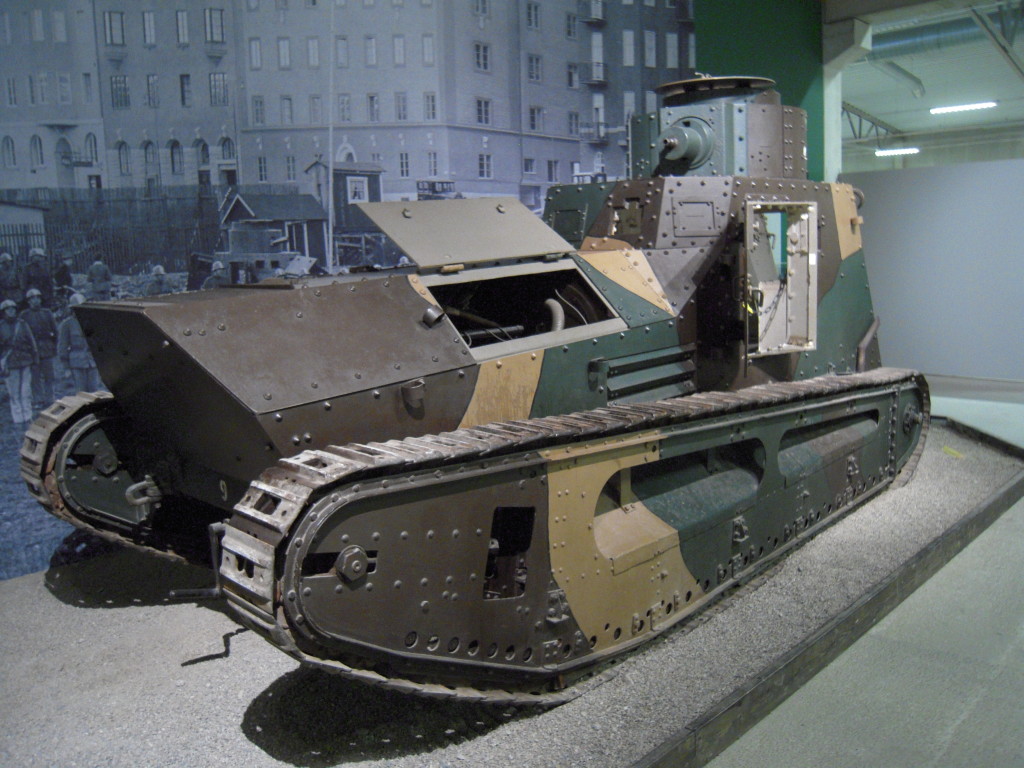
Stridsvagn m/21 (Strv m/21) was a Swedish version of the German LK II light tank, here seen at the Arsenalen Tank Museum, Sweden
For photographes of the Swedish Army Stridsvagn m/21 and additional information, my thanks and credit to http://blog.arsenalen.se/ from whom I sourced many the the m/21 photos below. Following are some photograph’s of the Swedish Army’s Stridsvagn m/21’s back in the day…
All photograph’s above of the Stridsvagn M21 are sourced from http://blog.arsenalen.se/en/2013/07/originalbilder/
The Hungarian Leichte Kampfwagen LK.II
Sometime in the early 1920’s a mysterious shipment arrived in Hungary. The 14 vehicles, which were listed as tractors, almost immediately disappeared from under the watchful gaze of the Allied Control Commission. Very few people had knowledge of the shipment and the carefully hidden parts reemerged only in 1927, after the departure of the Allied Control Commission from Hungary. At least most of them …
In 1928 the first tank squadron of the Hungarian Army was founded – and in the coming years this unit would be equipped with the contents of the mysterious cargo, after they were assembled. But only 6 of the 14 tanks shipped to Hungary eventually returned to service; Perhaps the other eight were destroyed during their time in hiding, but it is also possible that due to the secrecy of their shipment and concealment that certain parts or assemblies were simply lost (see the last paragraph in this context).
Since under the provisions of the Treaty of Trianon, Hungary was still permitted to have tanks, vehicles of the original “V” (tractor) wore the name, is also seen them in Roman numerals. Also because of the prohibition of the century worked within the Police Newbie School (Ruis) militia purposes, because some armored vehicles were allowed to keep operating. The otherwise unarmed tanks were fitted with a standard 8mm 7.12 M. Schwarzlose machine gun and it was using these tanks that gave the inaugural Hungarian armored arm officers their first experiences.
Difficulties with bringing the tanks into service are indicated by the fact that the new numbers do not follow the original sequence (V-12, according to the records was the number I tank, the other numbers indicate that V-14, V-11, V-7, V-6 and V-3 were received). Power was provided by a Mercedes-Benz engine, while according to the literature of the LK’s original engines; NAG-made engines should have been installed – perhaps the original engines were ruined while in hiding and needed replacement. Everything points to the original 14 tanks suffering serious damage, possibly suffered due to poor storage and having been transported on rail cars traveling back and forth to keep them concealed from the Allied Control Commission.
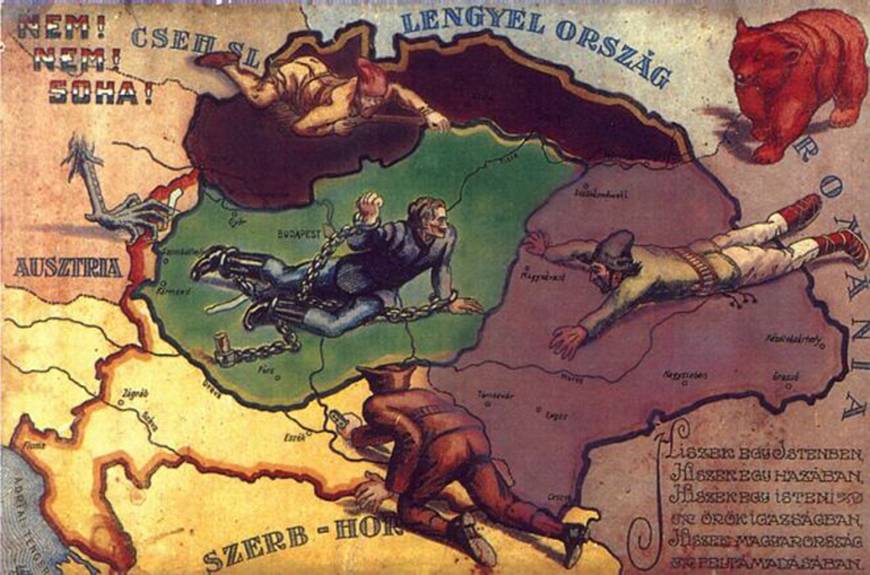
Hungarian poster reflecting Hungary’s suffering at the hands of her neighbours after her involuntary disarmament after WW1 – the Hungarians were unable to take any effective measures to prevent the break-up of their country and even today, 100 years later, many millions of Hungarians still live outside Hungary’s borders
The exact model of the mysterious tank remains a puzzle to this day. Some state that the shipment was of Swedish m/21 tanks. More likely, however, is that they were shipment of surviving German LK-II tanks, of which Sweden also had a few. The most likely scenario acording to the archival research of Lieutenant Nicholas Eder is that according to the records, the first two LK-II’s arrived in the spring of 1920, while the other 12 were shipped into the country after the German Army disarmament began, probably in pieces. No information on the procurement and delivery exists, but the Swedes may have played a role as intermediariesin this case. The most interesting part of the story is of the two LK.II tanks purchased for testing; This suggests that at least two LK.II’s were assembled and functional within Hungary in the early 1920’s.
Following the signing of the Peace Treaty, the possession of tanks by Hungary became illegal, but the military refused to give them up. Instead they entered into the popular 1920’s military sport of the “Hide”. In the coming years, parts of the disassembled vehicles were secretly hidden in the most isolated of rural farms, for example, or placed in railway freight wagons which traveled to and fro across the country, sometimes allegedly just behind the passenger car transporting the Control Commission agents … After 1928 the situation improved and it was possible to secretly assemble the tanks, more or less obsolete as they already were – but they were the only tanks Hungary had. They emerged from hiding have suffered from the harsh conditions of their storage – problems included corrosion and some parts having completely disappeared. Now, almost 100 years later, there is no record of the cicumstances but it is known that the Technical Department prepared drawings of the missing items. They may have been intended to be manufactured line, but if not, this may have contributed to less than half of the tanks being restored for sevice.
Finally, in 1930, the new armoured unit received five of the tanks for training, but by now they were hopelessly out of date and technically unreliable. Later in the same year. Hungary secretly made arrangements to buy tanks from a new ally – Italy. These were FIAT 3000 B tanks, derived from the Renault FT17. They weren’t that modern, but they were better than the old LK.II’s and they were brand new. The increasingly close relationship between the two countries seemed a favorable omen with respect to possible future purchases of tanks. Thus, as the FIAT models arrived, the old LK.II’s were gradually withdrawn from service in 1933 and all were shipped off to the scrap metal plants. Within a couple of years they had all slowly disappeared.
These tanks of mysterious origin thus left without a trace in the same way they were received. However, the story has one last and final twist still in store, just as in a novel or film. In 1939, the 2nd light tank company had been newly formed and a few bored soldiers began exploring their new home. The found an abandoned and boarded-up shed, inside of which was found a mysterious tank of an unknown type. Neither the soldiers nor their direct superiors knew the type of tank, so Captain Mészöly made enquriees. The response was that this was a type of tank that the army had scrapped years ago, and none remained. With this information, Captain Mészöly and his men in good conscience dismantled and sold the tank as scrap metal with the money received enriching the pot of the light tank company. In this way, the only remaining Hungarian LK-II met it’s final and sadly unceremonious end.
How did this tank survive until 1939,and why was it left assembled in the shed? This question will probably never receive an answer. More than likely it was one of the two tanks received for the 1920 trial, which was then hidden away and (after the death or retirement of witnesses) simply forgotten about.
(The above sourced from http://militiahungarorum.roncskutatas.hu/1867_f_j_h_s_l.html and translated using Google translate so forgive any screw-ups in the translation – and if anyone whose fluent in Hungarian and English wants to take the time to correct any mistakes – please do).
The Leichte Kampfwagen (Light Cavalry Tank) LK.III
The LK.III was to be an improved and redesigned version of the LK.II tank with a front mounted turret and rear mounted engine. It was no longer based on a Daimler car chassis, but rather on specially designed components. The main armament was to be either the Russian 57mm Sokol gun or the 20mm Becker Flieger Kanone. 1000 were ordered, but not even a prototype was completed before November of 1918.
Landsverk and the German connection
The Stridsvagn m/21 led to the Swedish army and government remaining open to further cooperation. However, in 1920 Landsverk, at the time a major Swedish heavy machinery manufacturer, was on the verge of going bankrupt. Working through a Netherlands front company, the German company Gutehoffnungshutte Aktenverein purchased half the stock and by 1925 had acquired more than 60%. Landsverk continued to manufacture trucks and tractors together with railroad and harbour equipment. It also developed a sideline in the manufacture of armoured vehicles, with German engineers, technicians and designs playing a significant part. Numbers of the resulting armoured vehicles were exported to various countries. However, as far as the German Army was concerned, Swedish society was too open to permit anything more than military tourism (such as Guderain in 1929 being given access to a Swedish tank, the first time had had drive one).
Sturmpanzerwagen Oberschlesien
It was also decided that a lighter tank was required which could spearhead assaults and which could be mass-produced – this was designated the Sturmpanzerwagen Oberschlesien. The basic plan involved a 19 ton vehicle with a crew of 5 – a far cry from the 33 ton A7V and it’s 18 man crew. The program was intended to supply large numbers of fast mobile armoured vehicles which could be mass-produced at low cost under war-time conditions.
Thirteen companies bid for the contract and in the middle of 1918 construction of a design by Captain Müller was assigned to the Oberschlesien Eisenwerk of Gleiwitz (in Upper Silesia), which had partially completed two prototypes by October 1918. It was a radical design for a fast-moving, lightly armored assault tank. The Oberschlesien included a track which was placed under the tank and only wrapped around half of it. The design sacrificed armor for the sake of speed and only required an Argus gasoline-fueled 180 hp engine for the 19 ton body, giving it a projected road speed of 10 mph and a cross-country speed of 5.5 mph. Range was estimated at 35-37 miles. The tank featured such advanced features as a main cannon mounted on top of the tank in a central revolving turret, separate fighting and engine compartments, a rear-mounted engine and a low track run.
For its time, the Oberschlesien was a rather modern-looking tank, though its combat effectiveness and actual performance can only be guessed at. Neither of the ordered test models nor the improved “Oberschlesien II” already planned were finished before the end of the war.
The Armistice & Aftermath
After the Armistice, all tanks in German hands were confiscated. Almost all were eventually scrapped, and the various postwar treaties forbade the former Central Powers from building or possessing tanks.
German Tanks of the Interwar Decades
The post-World War I Treaty of Versailles of 1919 prohibited the design, manufacture and deployment of tanks within the Reichswehr. When Imperial Germany fell to the Allies, the victors pushed for severe restrictions on the country’s war-making capabilities and Germany took the brunt of the blame to the west and was forced into signing the Treaty of Versailles in June 1919. Limitations for the post-WW1 German army included a 100,000-strong infantry army, absolutely no tanks of any kind and just a few armored vehicles. The German Army became a shell of its former self. Paragraph Twenty-four of the treaty provided for a 100,000-mark fine and imprisonment of up to six months for anybody who “[manufactured] armoured vehicles, tanks or similar machines, which may be turned to military use”.
Despite the manpower and technical limitations imposed upon the German Army by the Treaty of Versailles, the Reichswehr established a clandestine General Staff to study World War I and to develop future strategies and tactics. Hans von Seeckt became Commander-in-Chief and took to heart the lessons learned in the Great War. He was instrumental in rewriting the German Army’s doctrine. Infantry still remained the heart and soul of any planned offensive, but the tank would become the spearhead of actions that could shatter enemy defenses through speed, force and firepower.
Tactics involved the splitting up of enemy formations and counteractions involving pincer movements to surround and ultimately decimate the enemy. By 1926, German Army doctrine had been rewritten to fulfill this vision. While the Germans had not used large numbers of tanks in WW1, an emphasis on mobility was at the heart of German military doctrine and was a continuation of the highly successful storm-troop tactics of 1918. This, as the German Army began to examine the possibilities of tanks, thinking was very much in line with an emphasis on mobility which in turn was a continuation of the legacy of Hans von Seeckt. Officers such as Heinz Guderain were conformist to Prussian military thought, bringing to fruition ideas which were acceptable to the men around them, rather than non-conformists proposing radical change.
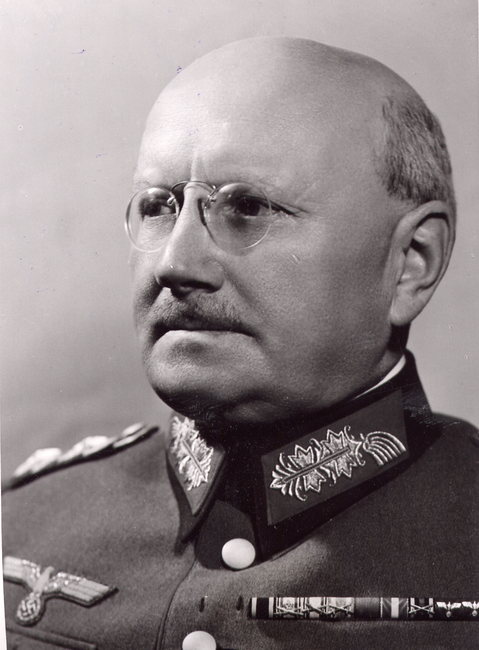
General Oswald Lutz (6 November 1876 – 26 February 1944) was a German General who oversaw the motorization of the German Army in the late 1920s and early 1930s and was appointed as the first General der Panzertruppe of the Wehrmacht in 1935.
In the late 1920s and early 1930s German tank theory was pioneered by two figures: General Oswald Lutz and his chief of staff, Lieutenant Colonel Heinz Guderian. Guderian became the more influential of the two and his ideas were widely publicized. Like his contemporary Sir Percy Hobart, Guderian initially envisioned an armored corps (panzerkorps) composed of several types of tanks. This included a slow infantry tank, armed with a small-caliber cannon and machine guns. The infantry tank, according to Guderian, was to be heavily armored to defend against enemy anti-tank guns and artillery. He also envisioned a fast breakthrough tank, similar to the British cruiser tank, which was to be armored against enemy anti-tank weapons and have a large 75-millimeter (2.95 in) main gun. Lastly, Germany would need a heavy tank, armed with a massive 150-millimeter (5.9 in) cannon to defeat enemy fortifications, and even stronger armor. Such a tank would require a weight of 70 to 100 tonnes and was completely impractical given the manufacturing capabilities of the day.
In the early 1930s, the German Army called upon a few German firms to put together some funded prototype light and medium tanks. At this time, the Army did not have a formal plan of action in terms of what it realistically needed. Light tanks could be made available in large quantities for a relatively low price while medium tanks afforded firepower but came at a price. At any rate, the German industrial infrastructure – both the post-war limitations and the economic damage caused by the crash of 1929 and the Great Depression – made the call easy for the Germany Army – the quest would start with the development of light tanks starting in the late 1920’s, with German industry was discretely encouraged to look into tank design while equally discrete cooperation was undertaken with the Soviet Union.
In 1931, Major-General Oswald Lutz was appointed the “Inspector of Motor Transport” in the German Army with Heinz Guderian as his Chief of Staff; they began building the German Armored Forces and put in place a program to design and build a light training tank with which to train future personnel of Panzer Divisions. And through the late 1920s and early 1930s, the Germans also closely co-operated with the Soviet Union in the development of armored vehicle doctrine at Kama, near Kazan in USSR. There was also minor military cooperation with Sweden, including the extraction of technical data that proved invaluable to early German tank design.
Johannes Friedrich “Hans” von Seeckt (22 April 1866 – 27 December 1936) was a German military officer who served as Chief of Staff to August von Mackensen, and was a central figure in planning the victories Mackensen achieved for Germany in the east during the First World War. With the Eleventh Army, Seeckt helped direct the Gorlice–Tarnów Offensive of 2 May – 27 June 1915, where he was credited with engineering Mackensen’s breakthrough which split the two Russian armies opposing them. The Russians never fully recovered. Here Seeckt implemented a change in handling the thrust of the offensive, pushing reserve formations through breaks in the Russian defenses. This was a break from the established method of securing flanks by advancing along a uniform front, using reserve formations to assist in overcoming strong points. By pressing the reserves forward into the Russian rear areas the Russian positions were destabilized, resulting in a collapse of the Russian defensive line. In 1917, Seeckt was sent to the Ottoman Empire to replace Colonel Friedrich Bronsart von Schellendorff as Chief of Staff of the Ottoman Army, where he would remain until the war ended.
During the years of the Weimar Republic he was chief of staff for the Reichswehr from 1919 to 1920 and commander in chief of the German Army from 1920 until he resigned in October 1926 (after permitting Prince Wilhelm, the grandson of the former emperor to attend army manoeuvres in the uniform of the old imperial First Foot Guards without first seeking government approval). During this period he engaged in the reorganization of the army and laid the foundation for the doctrine, tactics, organization, and training of the German army. Seeckt envisioned Germany winning the next war by a series of highly mobile operations featuring combined arms operations of artillery, infantry, armor, and air power working together to concentrate superior firepower to crush the enemy at crucial points. By the time Seeckt left the German Army in 1926 the Reichswehr had a clear, standardized operational doctrine, as well as a precise theory on the future methods of combat which greatly influenced the military campaigns fought by the Wehrmacht during the first half of the Second World War.
From 1930 up until his death in 1936, von Seeckt was repeatedly in Finland as a military consultant with Paamaja (Finland’s Supreme Headquarters) and guest lecturer to the Finnish military, where he continually stressed the need to train in combined arms operations. He became an enthusiastic supporter of Mannerheim’s goal of making the Finnish Army a combat force which could make up for what it lacked in quantity with the high quality of it’s professional and reservist soldiers and of it’s weapons – as well as of it’s doctrine. Seeckt urged Mannerheim (and, unofficially, influential members of the Finnish government and of Finnish political circles on the right) to further fortify the Karelian Isthmus, and to adopt policies to put in place sufficient arms and munitions manufacturing capability to ensure Finland was as self-sufficient as possible in armaments manufacturing. While Seeckt had worked with the Soviet Union in the past for purely practical reasons, he was strongly anti-communist and was dedicated to strengthening Germany. To this end, he continually urged stronger ties between Finland and Germany (to no avail as it turned out) after he had seen for himself the continually improving capabilities of the Finnish Armed Forces. By 1935, he would report that “…the Finnish Army, man for man, is better equipped and trained to a higher standard than even the soldiers of the Heer…”.
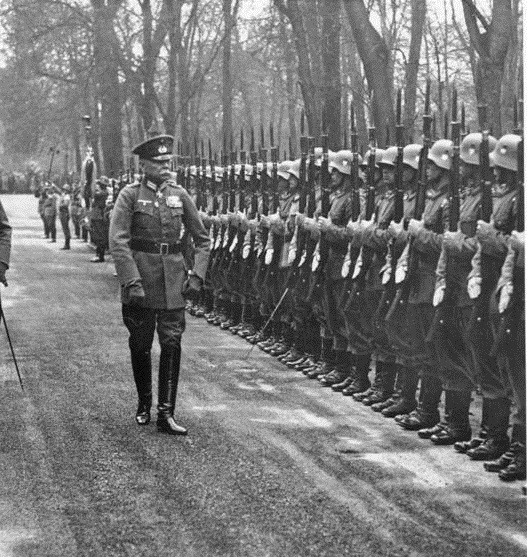
Von Seeckt with a Finnish Army guard of honor on the occasion of his 70th birthday, Helsinki, Finland, 22 April 1936
At a planning meeting in February 1934, von Seeckt’s plan for a 20 Division (60 Regimental Battle Group /Prikaati) force was adopted and a 5 year plan to reach the necessary force level was also agreed to. In March 1934, Mannerheim asked von Seeckt to remain in Finland on his personal staff as a Military Advisor and also to continue to lecture at the Finnish Defence Forces Schools for Staff Officers and for Officer training – and to assist with revisions to the overall military training curriculum. In this capacity, von Seeckt would have a marked effect on Finnish officer and NCO training, leading to the training standards of the Finnish Army becoming the toughest in the world, “…dare I say it, even tougher than the Reichswehr,” as he commented on a number of occasions. His 1921 book, “Leadership and Battle with Combined Arms” would become one of the core texts for Finnish Army Officers in training through the 1930’s.
In this, von Seeckt strongly influenced the ogoing development of the Finnish doctrine that would become known as the Ukkosota, the “Thunder War”: highly mobile operations featuring combined arms operations of artillery, infantry, armor, and air power working together to concentrate superior firepower to crush the enemy at crucial points. Von Seeckt served officially as a Lecturer at the Finnish Defence Forces Staff College, and unofficially as a military consultant to Marshal Mannerheim, up until his death in Berlin (whilst visiting home, where he expressed concerns about Hitler’s increasing power) on 27 December 1936. The British Ambassador to Finland initially expressed some concern at the role von Seeckt was playing within Finland, but a number of meetings with von Seeckt eventually convinced him otherwise. He came to view Seeckt as far too much an embarrassingly correct man to be involved in any covert German machinations with regard to Finland. The Ambassador added: ” .. the thoughts of General Seeckt towards Finland were generous and his views much more far reaching than one would expect from a man in such a tight fitting uniform and with such a pedantic exterior.”
By all accounts, von Seeckt apparently greatly enjoyed his time in Finland, being heard on one occasion to say that he had no regrets over turning down the offer of an advisory position in China as he felt he had achieved far more rewarding results in Finland than even with the German Army. He developed a deep respect for the Finnish Army and its senior officers and a close friendship with both Marshal Mannerheim and with that other frequent lecturer at the Finnish Staff College from late 1933 on, retired British Major General John Frederick Charles Fuller. From 1934 to von Seeckt’s death in late 1936, Mannerheim, Fuller and von Seeckt could often be seen in Helsinki eating lunch together. They would spend many evenings, together with other members of Mannerheim’s coterie, discussing strategy, tactics and technical and scientific developments with possible military ramifications.
In much of this, Fuller apparently poured forth a constant stream of thoughts and ideas – besides lecturing at the Staff College and to Finnish Army Officers Training Course, he also used his time in Helsinki to embark upon a second career as a writer, ultimately penning some 45 authoritative books and hundreds of popular-press articles and scholarly papers. He wrote about everything from war to yoga (the latter extremely avant-garde at the time). For all his personal foibles and failings, Fuller was a visionary – and in Helsinki, he was a visionary in the right place, at the right time, and with a critical and farsighted audience that analysed and examined his visions, sorting the kernels of wisdom from the chaff.
In the early 1930’s Fuller predicted, as Anthony Trythall wrote, that “….future armies would be surrounded by swarms of motorized guerillas, irregulars or regular troops making use of the multitude of civilian motorcars that would be available.” Fuller also mused that one day “a manless flying machine” would change the face of war. Early on he was intrigued by the development of radio, not only for communication but also as a way to control robot weapons. He also thought then-primitive rocket technology would one day lead to the development of superb anti-aircraft weapons. And as early as the 1920’s, Fuller was a proponent of amphibious warfare. He envisioned a naval fleet “which belches forth war on every strand, which vomits forth armies as never did the horse of Troy.” On the negative side of the balance sheet, Fuller also championed the military use of poison gas, particularly when spread by airplanes.
Many of these “visions” were picked up by the Finnish military: indeed, von Seeckt himself is believed have been influential in the Finnish military’s rapid adoption of amphibious warfare following disciussions on the topic with Fuller – certainly the timeframe for the founding of the Rannikkojaakarit seems to close to their recorded discussions on this topic to be a coincidence. Likewise the Ilmavoimat’s adoption of the “pigeon-guided glide-bomb” seems to have been partially influenced by Fuller’s thoughts on robot-controlled weapons. Fuller’s thoughts on rocket technology almost certainly led to the almost-at-the-last-minute introduction of the Finnish Army’s rocket artillery of WW2 – the infamous “Mannerheiminurut”, or Mannerheim’s Organ.
The TJ-R150 Taisteluajoneuvo, first used by the Finnish Army during the Winter War, was a fearsome weapon – with its unmistakable sound giving rise to its nickname of “Mannerheiminurut.”
Fuller’s contribution to the education of Finnish Officers through the last half of the 1930’s and the first half of the 1940’s can be summarized in a quotation still found on plaques in classrooms at the Finnish Officer’s School: “We shall teach each other: first, because we have a vast amount of experience behind us, and secondly, in my opinion it is only through free criticism of each other’s ideas that truth can be thrashed about…. During your course here no one is going to compel you to work, for the simple reason that a man who requires to be driven is not worth driving…thus you will become your own students and until you learn how to teach yourselves, you will never be taught by others….” Teaching was something Fuller was familiar with – from 1920, he had served a three-year tour as a professor at the British Army Staff College and he had enjoyed this period of his life.
On Fuller’s retirement from the British Army in 1933, the attractive offer from Finland had appealed to him, giving him the opportunity to lecture whilst also continuing with his writing. It was in fact in this period that he completed and published “Grant and Lee: A Study in Personality and Generalship, an outstanding contribution to the body of knowledge concerning the strategic leadership of the American Civil War. Fuller, von Seeckt, Manerheim and that architect of the Finnish Army’s doctrine of Ukkosota, Kenraaliluutnantti Aksel Airo, all found themselves on common ground in their endorsement of Clausewitz’s five strategic principles: these were principles which became deeply embedded in the Ukkosota:
- First and most important is to employ all the forces that we can make available with the utmost energy.
- The second is to concentrate our force at the point were the decisive blows are to be struck, to run the risk even of being at a disadvantage at other points, in order to make sure of the result at the decisive point, the success at that point will compensate for all defeats a secondary points.
- The third principle is not to lose time…by rapidity many measures of the enemy are nipped in the bud and public opinion is gained in our favor.
- The fourth is surprise…it is the most powerful element of victory.
- And the last is to follow up successive gains with the utmost energy. The pursuit of the enemy when defeated is the only means of gathering up the fruits of victory.
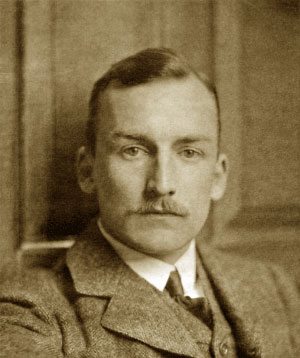
J F C Fuller as a young man, he retired in 1933 as a Major-General and thereafter served as a consultant and guest lecturer at the Finnish military’s Staff College (1934-46)
Many other of Fuller’s maxims found their way into the Ukkosota, including these:
“…If…we can strike a crushing blow first, even if we only crush a small force of the enemy, we not only gain a physical victory…but a moral victory. Finding is the first step towards maneuvering; just as hitting is the first step in holding. Only when an enemy is held, is liberty of maneuver gained and liberty of movement carries with it freedom of action, which is the aim of all generalship.”
“Uncertainty arises from fear of the unknown…It teaches us that the rear demoralizes the front; that to surprise the front we must attack the rear. First the rear of the front, secondly the rear of the reserves, thirdly the rear of the command and so on back to the initial will of the people who desire victory and dread defeat.” (Note that in this, Fuller to a certain extent inspired the setting up of that first Finnish Army Special Forces unit, Osasto Nyrkki, whose objective was very specifically to create disruption and havoc in the enemy rear at a strategic level).
“There are two main causes for military shortsightedness: the first is the worship of traditions, and the second is our incapacity to see world forces in their true relationship….”
In 1934, Fuller would attempt an initial answer to the following key strategic question facing Finland’s defence forces: “How are we going to secure Finland by means of our small army, small airforce and small navy?” Fuller’s guidance on how to overcome Finland’s constraints on resources was: “As you cannot increase the size of your military forces; consequently there is only one thing to do, reduce the size of the world to fit your force.” Reducing the size of the world to fit Finland’s forces would be accomplished by “increasing the present speed of military movement so that your securities, through enhanced mobility, may be brought to balance your liabilities.” In its essence, Fuller advocated using speed, superior weapons, concentration of forces at key decision points and firepower to offset the Soviet Union’s overwhelming advantage in manpower.
If Fuller had a fatal flaw as a tactician, it was that he derided the importance of putting infantry “boots on the ground.” To Fuller, combat was simply a matter of wool uniforms versus steel armor — and that seemed to him a no-brainer. In this, Fuller had failed to consider the development of effective antitank weaponry – a deficiency which the Finnish Army inadvertently corrected on one of Fuller’s visits to Spain during the Spanish Civil War, where he made three visits as a war correspondent, writing dramatic, anti-Republican articles for the Sunday Dispatch. He had the good fortune to be visiting Pohjan Pohjat at the front and was an observer to a Republican tank attack which was ripped to shreds by two batteries of Pohjan Pohjat’s Bofors 76mm AA guns in their anti-tank role. As a direct result, he contributed heavily to the debate within the Finnish military that led to the rapid and large-scale adoption of these guns as an “antidote” to the numerical strength of Soviet armoured formations – and indeed, it would be the Finnish Army’s plethora of anti-tank guns which would break the back of Soviet armour in the Winter War – as it would be the Finnish Artillery and Rocket Artillery that broke the back of the Soviet infantry attacks.
It would be the Finnish Artillery that broke the back of the massed Soviet infantry in the Winter War
In later years, Mannerheim and Fuller continued that tradition of lunches that had first begun with von Seeckt. Often they were to be seen eating together at Helsinki’s Savoy Restaurant, which opened on what happened to be Mannerheim’s seventieth birthday, June 4, 1937. This extraordinarily beautiful restaurant — with its hedged terrace jutting out over the trees lining Helsinki’s Esplanade shopping street — was the creation of Alvar Aalto, surely one of Finland’s, and Europe’s most influential and honored architects and designers. The décor is of carved and rounded, stained and polished, birch; the seating padded with black leather. Ceilings and walls are of olive-wood-grained blocks. Aalto’s free-form vases, known throughout the world, adorn the restaurant. The lighting fixtures, the serving stations, even the coat racks are Aalto’s — the same now as when the Savoy opened so many decades ago.
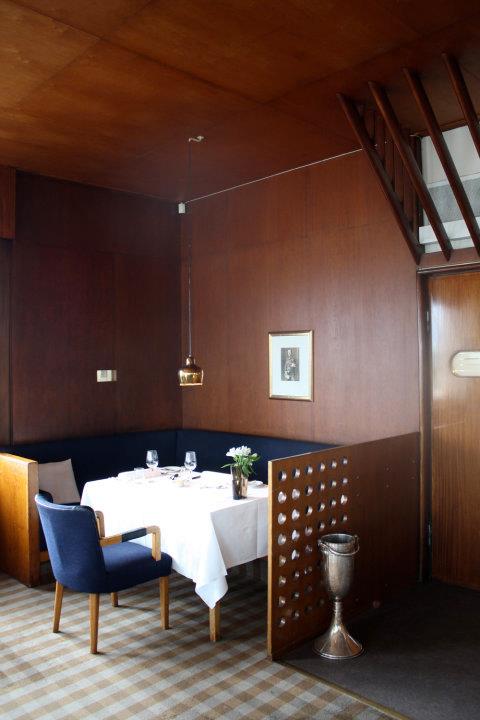
The corner table at the Ravintola Savoy – here, Mannerheim, von Seeckt and Fuller would spend many a lunch…..
At the far end of the restaurant is a corner banquette, and on the two walls that meet in that corner there is an etching of Marshal Mannerheim and a small bronze plaque identifying the bench as his customary luncheon seat. There, the Marshal and “Boney” Fuller would first drink a brimming glass of schnapps (the glasses having been carefully frozen beforehand according to the Marshall’s instructions), after which they would eat a lunch of vorshmack (for which Fuller, under Mannerheim’s tutelage, had acquired a taste), often followed by fillet of perch, grilled, brushed with butter, and served with grated horseradish and succeeded by a a dessert of apple baked in a ramekin with vanilla sauce and a touch of Madeira.
While Fuller was impatient with what he considered the inability of Britain as a democracy to adopt military reforms, he considered Finland to be an example of “…. what a democracy with a people firmly committed to a common goal can achieve by way of preparation for war”. And in this belief that a major European war was coming, Fuller and Marshall Mannerheim were completely in accord. Between 1934 and 1930, when not visiting and lecturing in Finland, Fuller would spend some time back in Brtain and here, he became loosely involved with Sir Oswald Mosley and the British Fascist movement as well as joining the clandestine far right group the Nordic League. As a member of the British Union of Fascists he was asked to sit on the party’s Policy Directorate but while considered one of Mosley’s closest allies, he chose to decline, citing the demands on his time imposed by his lecturing work at the Finnish Staff College and at the Finnish Army’s Officer Training School.
Fuller’s guest lecturer position at the Finnish Staff College was somewhat of a joke within the British military in the late 1930’s – while Fuller had his admirers, he also had many detractors and his vigorous, expressive and opinionated personality did not go down well with many. There was certainly considerable amusement among his detractors at his position “lecturing on bone-headed theories to a second rate military in a minor country of importance to no-one” as one such detractor put it. The last laugh would however be Fuller’s, when “his” military soundly thrashed both the Soviet Union and Germany, something Fuller would make no bones about rubbing in when in 1947 he published his magnificent opus, “The Generalship of Marshal Mannerheim” (Eyre & Spottiswoode, London, 1947).
Both Fuller and von Seeckt would be major contributors to the ongoing development of the Finnish battle doctrine of Ukkosota and both would be great admirers of the Finnish Army. Indeed, in the late summer of 1939, on the eve of the Winter War, at a reception after Fuller had watched a parade of the fully mechanized 21st Panssaaridivisoona through Helsinki, Kenraalimajuri Ruben Lagus, commander of the 21st, would greet Fuller with a handshake, saying “I hope you were pleased with your children.” Fuller is said to have replied, “Lagus, they have grown up so quickly that I no longer recognize them.”
Fuller was not recalled to service by the British Army on the outbreak of WW2 – indeed, he was the only retired officer of his rank in the British Army not invited to return to service during the war. While he did request a service position, he was not heart-broken when this was declined. Instead, he chose to return to Finland and would spend the years 1939-1945 continuing to lecture at Finnish Army Officers Training Courses and at the Finnish Staff College, as well as preparing detailed analyses of Soviet (and later, German) tactics and performance.
And now we leave von Seeckt and Fuller and return to the German Tanks of the Interwar Decades once more…….
The Großtraktor
In 1925, the Weapons Office produced conceptual requirements for a 16-ton vehicle with a top speed of 25mph, 14mm of armour and a turret mounted 75mm gun. Three firms responded and as early as 1926 these three German companies (Rheinmetall-Borsig, Daimler-Benz and Krupp) each produced a single prototype armed with a large 75-millimeter cannon (the Großtraktor, “large tractor”, was so codenamed to veil the true purpose of the vehicle). Krupp and Rheinmetall-Borsig had a lengthy history of arms production while Daimler-Benz was an automobile manufacturer. None of these companies gave the project a high priority.
The Großtraktor was designed as a heavy breakthrough vehicle. The prototype vehicles had differences; however what follows was true of at least one or more of the models. The main armament was the same short 7.5 cm gun initially used on the Panzer IV; with secondary armaments including multiple machine guns. The approximate weight was 16 tons. The engine was a six-cylinder engine, in the 250-260 hp range.
The following may have applied only to the Rheinmetall-Borsig and Krupp designs: a machine gun was placed at the rear of the tank, behind the turret; and the tank commander sat not in the turret, but in the hull to the right of the driver (Zaloga 13-14). The Großtraktor prototypes were constructed of mild steel and two were tested at the Kama testing facility near Kazan in the USSR, called by the Germans Panzertruppenschule Kama (Armoured Troops School Kama and used from 1926 to 1933).
One result of the experimentation in Kazan was that the German Army Motorization Department felt compelled to field two tank types corresponding to the Großtraktor and the Leichttraktor; codenamed the BW and ZW. The BW reference being for Battalionführerwagen, or the Battalion commander’s vehicle; which was intended to be a fire support vehicle. The BW was to accompany the ZW, the Zugführerwagen, or Section commander’s vehicle intended to act as the core battle tank (Zaloga 13-14). The work on the Großtraktor led to the Neubaufahrzeug, a similar heavy tank design. The prototypes were decommissioned in 1937; at least one ended up as a memorial to early armored regiments.
The Schlepper Self-propelled Guns
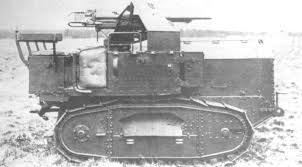
3.7cm WD Schlepper 25PS, which was a lightly armored 25hp Hanomag WD tractor with a pedestal mounted 37mm PaK L/45 gun.
In 1927, the Germans designed two self-propelled guns based on fully tracked Hamomag tractors (commercial Hanomag tractors were already in use with the army). The first was the 3.7cm WD Schlepper 25PS, which was a lightly armored 25hp Hanomag WD tractor with a pedestal mounted 37mm PaK L/45 gun. The gun had a limited traverse of 30 degrees maximum. The vehicle also carried single machine gun for defence.
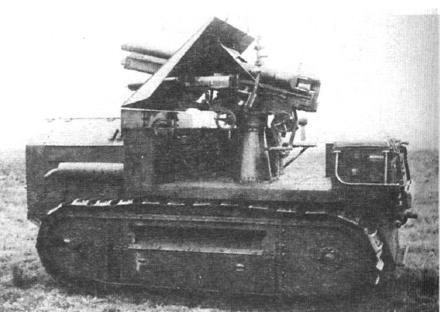
7.7cm WD Schlepper 50PS, which was a 50hp Hanomag WD tractor with a pedestal mounted 77mm K light gun.
The second was the 7.7cm WD Schlepper 50PS, which was a 50hp Hanomag WD tractor with a pedestal mounted 77mm K light gun. The gun had a full 360 degrees traverse.Both self-propelled guns were accepted into service with the German Army in 1927. Small numbers of vehicles were produced and used mainly for testing.
The Leichttraktor
The Leichttraktor (VK-31) was a German experimental tank, which, as part of its cover, was described as a light tractor, which translated in to German was “Leichttraktor”. Work started on the VK-31 two years after the heavy Grosstraktor. A request for tender for a tracked combat vehicle up to 12 tons in weight was released by the Reichswehr on March 28, 1928. Prototypes were to be constructed by 1930 and cost less than 50 000 Reichsmarks. The winner would receive an order for at least 17 tanks. The request was delivered to Daimler-Benz, Krupp, and Rheinmetall-Borsig in May of 1928. By that time, the weight requirement had been restricted to 7.5 tons. Additional requirements included 14 mm of front and side armour and a crew of 4. The armament of the VK-31 was to be a 37 mm KwKL/45 main gun and a 7.92 mm Dreyse machine gun. The crew of the VK 31 in both firms designs consisted of four people: the driver, commander, radio operator and loader.
The tank also had to have a radio to provide voice communication with a range of 2-3 km and a morse capability of up to 7 km. Chemical protection was also required, in case of a gas attack. Maximum highway speed was to be 25-30 kph (40 kph by some sources) and 20 kph off-road. A range of 150 km or 6 hours of continuous movement was specified. The tank also had to be able to ford water 0.6 m deep, a 1.5 m wide ditch and climb a 60% (31°) slope for up to 1 km at a minimum speed of 3 kmh. To improve cross-country performance, ground pressure should not exceed 0.5 kg/sq.m. The specification was approved on 19 July 1928.
Daimler-Benz refused to participate, leaving Krupp and Rheinmetall-Borsig in the competition. Both companies co-operated to develop a “Kleintraktor” (renamed “Leichttraktor”, or light tractor) together, and their results were consequently very similar, with the engine at the front and a turret at the rear. Not having much experience with tank suspensions, Rheinmetall engineers used the tracks from an existing tractor. Each side had 12 road wheels, two wheels per bogey, one tension idler, and two support idlers, a front directing, and a rear leading wheel. In order to protect this system, a side screen was retained, with three openings to clean the mud out of the suspension. The hull was a combination of welded and bolted, with armoured steel 4-10 mm thick. The layout was inherited from a tractor. The front, which had the transmission, also housed a Daimler-Benz M36 engine, 36 hp in power. The middle part had the control compartment (the driver sat on the left side). The driver had a small rectangular turret with vision ports above his head.
Krupp engineers did not trust tractors and built their own chassis. Krupp’s prototype vehicle was slightly longer and taller, which allowed two hatches on the side for entrance and evacuation. The Krupp tank had 6 small diameter road wheels per side, with a vertical spring suspension, grouped in two groups of three, with the front-most and rear-most wheels slightly larger than the others. There were also two idlers, a front directing, and a rear leading wheel. Rheinmetall was responsible for both turrets. All VK 31s had radio stations. Four prototypes with different armament, crew, weight, and suspension features were manufactured (numbers 37 & 38 by Krupp, and numbers 39 and 40 by Rheinmetall.
The four prototypes were shipped to the Soviet-German joint testing ground and tank training ground (known to the Germans as Panzertruppenschule Kama) near Kazan. The facility had been established under the terms of the Treaty of Rapallo – agreed to between the USSR and Germany in 1922 under conditions of high secrecy and security. The testing facility was used from 1926 throught to 1933 and was codenamed “Kama” (from a combination of the words Kazan and the surname of Reichswehr Oberstleutenant Malbrandt, who had been assigned to select the location for testing. The facility was consequently codenamed KaMa – for Kazan-Malbrandt). All four Leichttraktor (VK-31) prototypes were shipped to Kama where the Special Technical Commission (TEKO) created to exchange experience in the area of tank design and construction, began its work.
By 1933, each prototype had traveled between 1,660 and 1,865 km. Soviet specialists agreed that these vehicles are not of any interest to the RKKA. However, Soviet engineers were interested in the suspension and the turret layout (particularly the coaxial machine gun), as well as the tanks’ radios. German specialists were not impressed by the technical and tactical data either. Installing the engine in front of the tank to some extent saved the crew from death or injury in combat, but the thickness of the armor was obviously not enough, and could not keep out shells and larger caliber bullets. Further modernization and up-armouring was not possible without increasing weight, and reducing the already unimpressive mobility of the tanks. In addition, because of the shortcomings of the cooling system, the enginese frequently overheated and the durability the tracks was extremely low.
All four Leichttraktors were shipped back to Germany in 1933, when KaMa was closed down. In 1934, the tanks were moved to Munster for the winter. From 1935 to the start of WWII, they were used as training vehicles in Pultos. One source mentions that Rheinmetall won a production order of 289 vehicles around 1928 but that the order was subsequently cancelled as better lighter tank designs (the Kleintraktor, which would go on to be rather more well known as the Panzerkampfwagen I) came along; however, there is no source for this statement that 289 were ordered mentioned.
In 1933 another prototype light tank was built which could be classified as a self-propelled gun. Instead of a turret, a fixed PaK L / 45 caliber 37 mm (antitank variant) gun was installed with vertical guidance adjustment from -10 ° to + 30 °. The crew was reduced to three. It has been mentioned that this modification was a Rheinmetall prototype, but judging from the chassis it was a modification of a Krupp prototype. Unfortunately, the details of the tests of this machine are unknown.
The Neubaufahrzeug
As was mentioned in the post on British Tanks, during the 1920s and 1930s, a number of countries experimented with very large, multi-turreted tanks. The British built a single example of the Vickers A1E1 Independent in 1926. This inspired the Soviet T-35, which was built in limited numbers from 1933. Likewise, in Germany development of the Neubaufahrzeug (German for “new construction vehicle”) started in 1933 when the then Reichswehr gave a contract for the development of a Großtraktor (“heavy tractor”) to both Rheinmetall and Krupp. Großtraktor was a codename for the development of a heavy tank, Germany being still forbidden to develop tanks under the terms of the Treaty of Versailles. The Rheinmetall and Krupp designs resembled each other to a great extent, the main difference being the weapons placement. The original design had a main turret armed with a 75 mm KwK L/24 main gun and secondary 37 mm KwK L/45. Rheinmetall’s design mounted the second gun above the 75 mm KwK L/24, while the Krupp design had it mounted next to the 75 mm KwK L/24. Both designs had a secondary turret mounted to the front and the rear of the main turret.
Rheinmetall’s design was designated the PzKpfw NbFz V (PanzerKampfwagen NeubauFahrzeug V), and the Krupp design the PzKpfw NbFz VI. It was intended that these designs would fulfill the role of heavy tank in the armored forces, but the design proved to be too complex and unreliable for this role. Nevertheless, development continued in order for the nascent German military to gain experience with multi-turreted tanks. In 1934 Rheinmetall built two mild steel prototypes with a partially welded hull, both with their own turret design. Three more prototypes were built with proper armor and the Krupp turret in 1935 and 1936. The first prototype had the original Rheinmetall turret with tandem guns (the 37mm Tankkanone L/45 was installed over a 75mm KwK L/24), and a horse-shoe FuG turret antenna. The other four were given the Krupp turret (with coaxial guns).
The two secondary turret were mounted in a lozenge configuration, one on the front left and the other one the right rear. The driver’s compartment was next to the front turret, with the main fighting compartment behind. There were two rear hatches for the original BMW engine (Type A), replaced with four hatches for the more powerful, gasoline Maybach HL 108 TR of 120rpm, both fed by a 457 liter capacity fuel tank. Transmission was with a crash gearbox, 5 speed forward, no reverse. The modified coil (leaf) spring suspension system was composed of a set of five paired road wheels bogies pivoted to Christie type torsion arms and two front single road wheels suspended independently (similar to the British A1E1 and Russian T28). They were protected by side skirts with mud chutes in échelon (under each return roller), with two access doors to the suspension. The Turrets were also provided with large, one piece side hatches for access. The commander’s cupola was at the rear end of the turret. Provision for ammunition was 80 rounds for the main gun, 50 for the coaxial 37mm, and around 6000 for the two Mg.34 Mgs. Armour was no thicker than other Panzers of the time, – in other words it was just enough to provide minimal protection against infantry weapons, light AT guns and shrapnel.
Soon after delivery, the three late prototypes were extensively tested at the proving grounds at Putloss while the two earlier versions took part in army manoeuvers. However, by the end of 1936, it was decided to cancel all further development of the series, with priority being given to the construction of the light and medium Panzer I, II, II and IV. Nevertheless, they were displayed in propaganda events, shows and on newsreels, including the International Automobile Exposition in Berlin in 1939. They were deployed in Norway, being landed at Oslo harbour on 19 April, 19 1940 and taking part in local operations. Although handicapped by their slow speed, they were still an impressive sight, and by far the most heavily armed German tank ever fielded in operations, combining the firepower of a Panzer III and IV and two Panzer I’s in a single package. This unit was later posted toAkershus Fortress (Oslo) in Norway in 1941 and their eventual fate is unclear, although they were captured in Norway by 1945 and apparently scrapped afterwards. The two others may have taken part in operations in Ukraine and Rumania.
The Panzerkampfwagen I
Soon after rising to power in Germany, Adolf Hitler approved the creation of Germany’s first panzer divisions. Simplifying an earlier proposal, Guderian suggested the design of a main combat vehicle which would later be developed into the Panzer III, and a breakthrough tank, the Panzer IV. No existing design appealed to Guderian and so, as a stopgap, the German Army ordered a preliminary design for a vehicle with which to train German tank crews. This became the Panzer I, which was itended not just to train Germany’s panzer troops, but to prepare Germany’s industry for the mass production of tanks in the near future: a difficult engineering challenge for that time.
The Panzer I’s design history can be traced back to 1932’s Landwirtschaftlicher Schlepper (La S) (Agricultural Tractor) armored fighting vehicle. The La S was intended not just to train Germany’s panzer troops, but to prepare Germany’s industry for the mass production of tanks in the near future: a difficult engineering feat for the time. In July of 1932, Krupp revealed a prototype of the Landswerk Krupp A, or LKA, with a sloped front glacis plate and large central casemate, a design heavily influenced by the British Carden Loyd tankette. The tank was armed with two obsolescent 7.92-millimeter (.312 in) MG-13 Dreyse machine guns. Machine guns were known to be largely useless against even the lightest tank armor of the time, restricting the Panzer I to a training and anti-infantry role by design.
A mass-produced version of the LKA was designed by a joint team from Daimler-Benz, Henschel, Krupp, MAN, and Rheinmetall, exchanging the casemate for a rotating turret. This version was accepted into service after testing in 1934. Although these tanks were referred to as the La S and LKA well beyond the start of production, the official designation, assigned in 1938, was Panzerkampfwagen I Ausführung. A (‘Model A’ or, more accurately, ‘Batch A’). The first fifteen tanks, produced between February and March 1934, did not include the rotating turret and were used for crew training. Following these, production was switched to the combat version of the tank.
The Ausf. A was under-armored, with steel plate of only 13 millimeters (0.51 in) at its thickest. The tank had several design flaws, including suspension problems (which made the vehicle pitch at high velocities) and engine overheating. The driver was positioned inside the hull at the front and used conventional steering levers to control the tank, while the commander was positioned in the turret where he also acted as gunner. The two crewmen could communicate by means of a voice tube. Machine gun ammunition was stowed in five bins, containing numbers of 25-round magazines. Author Lucas Molina Franco suggests that 833 Panzerkampfwagen I Ausf. A tanks were built in total, while authors Bryan Perrett offers the number of 300 and Terry Gander 818 units.
Many of the problems in the Ausf. A were corrected with the introduction of the Ausf. B. The engine was replaced by the water-cooled, six-cylinder Maybach NL 38 TR, developing 98 horsepower (73 kW), and the gearbox was changed to a more reliable model. The larger engine required the extension of the vehicle’s chassis by 40 cm (16 in), and this allowed the improvement of the tank’s suspension, adding another bogie wheel and raising the tensioner. The tank’s weight increased by 0.4 tons. Production of the Ausf. B began in August 1935 and finished in early 1937 – Franco writes that 840 were constructed but notes that only 675 of these were combat models, while Perrett suggests a total number of 1,500 (offsetting the low number of Ausf. A, he proposes) and Gander a total of 675.
Lessons learned from Panzerkampfwagen I provided the German designers and manufacturers with valuable experience in designing and producing next generation of new panzers that were soon to come. Although the Panzerkampfwagen I was not a superb combat tank, it proved to be an excellent training tank and most of the panzer crews would be trained on Panzerkampfwagen I’s until the end of the war. The Germans also built the SdKfz 265 Panzerbefehlswagen – this was the German Army’s first purpose-designed command tank, converted from the Panzer I Ausf B, and was the primary German command tank in service at the beginning of World War II – 200 of these were manufactured
The SdKfz 265 Panzerbefehlswagen
The SdKfz 265 Panzerbefehlswagen was the German Army’s first purpose-designed command tank, and the primary German command tank in service at the beginning of World War II. Converted from the Panzer I Ausf. B, the SdKfz 265 was to see considerable action during the early years of the War. The SdKfz 265 was designed to fulfil a growing need within the German Army for a command tank, following the realization that the leaders of a massive panzer formation would themselves have to travel in a tank of some type. This vehicle would have to carry extra equipment and personnel to assist the field commander in his duties. In 1935 Krupp offered a command tank design based on the existing Panzer I Ausf B training tank chassis. The Ausf. B was a turretless chassis version of the Panzer I designed solely to train tank drivers, and lent itself easily to conversion into a command vehicle.
To increase space for a radio operator the rotating turret of the PzKpfw IB was eliminated and replaced with a larger fixed “box” superstructure. This allowed room for map boards, paperwork and a more powerful FuG6 radio transmitter in addition to the earlier FuG2 radio (Panzer I’s had only FuG2 radio receivers). Despite these modifications the vehicle’s interior remained small, a factor leading to its rapid replacement by conversions of larger tanks. The cramped quarters also made operation of the vehicle’s single ball-mounted MG13 or MG34 machine gun virtually impossible. Because of this, most SdKfz 265 were also equipped with pistol ports, and many had their machine guns removed entirely. A large frame antenna was mounted to the hull of many early version SdKfz 265’s. The antenna gave the upgraded radio transmitter units better range and reception.
Because it would be necessary for a command tank to keep up with the tanks under its command, the original 60 hp Krupp M305 gasoline engine of the Panzer I was replaced by the more powerful 100 hp Maybach NL38TR gasoline engine, resulting in a design that was 3 km/h faster, despite weighing 300 kg more than the Panzer I. Increased fuel capacity also gave the SdKfz 265 a range of 290 kilometres, nearly 160 kilometres further than the Panzer I. Despite its ungainly appearance, the SdKfz 265 was only 1.97 m high, only 25 cm taller than the original Panzer IB. About 190 SdKfz 265 Panzerbefehlswagen conversions were produced by Daimler-Benz between 1935 and 1937, and were produced at the same time as the Ausf B. Between 1935 and 1940 the SdKfz 265 Panzerbefehlswagen was the standard command tank of the German Panzer divisions. Each Panzer division contained sixteen tank companies, grouped into four battalions, two regiments or one brigade, for a total of twenty-three headquarters. Each headquarters would be issued at least one command tank.
At least four saw service in Spain in the Spanish Civil War.
The Panzerkampfwagen I and the Spanish Civil War
On 18 July 1936, Spain dissolved into civil war. After the chaos of the initial military coup and the subsequent uprising of the various leftist, anarchist and communist movements, two sides coalesced and began to consolidate their position—the Popular Front (the Republicans) and the Spanish Nationalists. In an early example of a proxy war, both sides quickly received support from other countries, most notably the Soviet Union (supporting the Republicans) and Germany & Italy (supporting the Nationalists); both sides saw, in addition to political gains, an opportunity to test their tactics and equipment.
The first shipment of foreign tanks, 50 Soviet T-26s, arrived on 15 October. The shipment was under the surveillance of Nazi Germany’s Kriegsmarine and Germany immediately responded a few days later. The first 32 PzKpfw I’ Ausf A’s along with single a Kleiner Panzer Befehlswagen I arrived in October 1936. This first shipment was followed by four more shipments of Panzer I Ausf. B’s and 4 Kleiner Panzer Befehlswagen I’s for a total of 122 vehicles (different sources quote differing totals). The tanks saw service with the “Condor Legion” (within Major Wilhelm Ritter von Thoma’s Panzer Abteilung 88, also known as Abteilung Drohne). Pz.Abt.88 with its 3 companies was based at Cubas near Toledo, where German instructors trained Spanish tank crews,
The first tank battle of the Civil War ook place during the defence of Madrid in October 1936 when, in an attempt to stem the Nationalist tide and gain crucial time for Madrid’s defence, Soviet armor was deployed south of the city under the command of Colonel Krivoshein before the end of October. At this time, several T-26 tanks under the command of Captain Paul Arman were thrown into a Republican counterattack directed towards the town of Torrejon de Velasco in an attempt to cut off the Nationalist advance north. Despite initial success, poor communication between the Soviet Republican armor and Spanish Republican infantry caused the isolation of Captain Arman’s force and the subsequent destruction of a number of tanks. This battle also marked the first use of the molotov cocktail against tanks. Ritter von Thoma’s Panzer I’s fought for the Nationalists only days later on 30 October, and immediately experienced problems. As the Nationalist armor advanced, it was engaged by the Commune de Paris battalion, equipped with Soviet BA-10 armored cars. The 45-millimeter gun with which the BA-10 was armed was more than sufficient to knock out the poorly armored Panzer I’s at ranges below 500 meters (550 yd).
Although the Panzer I would participate in almost every major Nationalist offensive of the war, the Nationalist army began to deploy more and more captured T-26 tanks to offset their disadvantage in protection and firepower. At one point, von Thoma offered up to 500 pesetas for each T-26 captured. Although the Panzer I was initially able to knock out the T-26 at close range—150 meters (165 yd) or less—using an armor-piercing 7.92 millimeter bullets, the Republican tanks began to engage at ranges where they were immune to the machine guns of the Panzer I.
The Panzer I was upgraded in order to increase its lethality. On 8 August 1937, Generalísimo Francisco Franco expressed the need for a Panzer I armed with a 20-millimeter gun. Ultimately, the piece chosen was the Breda Model 1935, due to the simplicity of the design over competitors such as the German Flak 30. Furthermore, the 20 mm Breda was capable of penetrating 40 millimeters of armor at 250 meters (1.57 inches at 275 yd), which was more than sufficient to penetrate the frontal armor of the T-26. Prototypes were ready by September 1937 and an order was placed after successful results. The mounting of the Breda in the Panzer I required the original turret to be opened at the top and then extended. Four of these tanks were modified at the Armament Factory of Seville, but further production was canceled as it was decided sufficient numbers of Republican T-26 tanks had been captured to fulfill the Nationalist leadership’s request for more lethal tanks. The Breda modification was not particularly liked by German crews, as the unprotected gap in the turret, designed to allow the tank’s commander to aim, was found to be a dangerous weak point.
Overall, in the Spanish Civil War, the Panzerkampfwagen I tanks proved to be outclassed by Soviet T-26 and BT-5’s provided to the “Republicans”.
Finnish Volunteers in Spain and the Panzerkampfwagen I
In the early 1930’s, as we have seen, the Finnish Army started planning for the creation and maintenance of a modern armoured force. While Paamaja (the Finnish Army’s Supreme Headquarters) established a framework for the first large-scale Panssaari units, only limited guidance on tactical doctrine was provided. The staff of the early Panssaari units and of the Combined Arms Experimental Brigade were tasked with the development of detailed tactical doctrine for combined arms warfare from 1932 on. The Spanish Civil War provided a live test-bed for testing and evolution of this tactical doctrine on an ongoing basis over four years of continuous fighting.
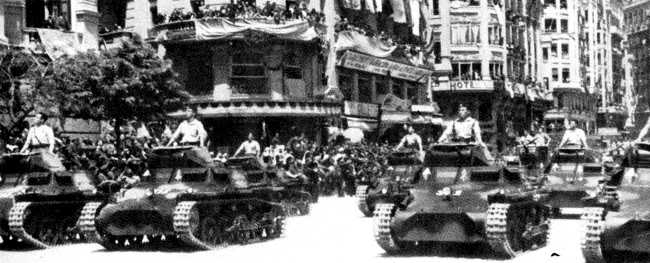
Panzer I’s of Pohjan Pohjat’s Panssaaripataljoon particpating in the Nationalist victory parade through Madrid
As has been mentioned, the Finnish Volunteer Brigade in Spain (Pohjan Pohjat) would include a Panssaripataljoona (Panzer Battalion). Initially, this Battalion was equipped with Italian-supplied CV33 and CV35 tanks, but would soon include a company of German-supplied Panzerkampfwagen I Ausf B’s and later still numbers of captured Republican T-26’s (and some Finnish tanks). Two SdKfz 265 Panzerbefehlswagen command tanks were also supplied by the Germans to the Finnish volunteers. Later in the Spanish Civil War, the Finnish Army would indirectly equip a small number of the volunteer Panssari troops with an assortment of Vicker’s 6-ton tanks and Skoda LT34’s. The Pohjan Pohjat volunteers would acquire a great deal of experience with these tank designs in combat over four years of fighting in the Civil War. The tanks themselves were evaluated for strengths, weaknesses and flaws, various modifications were tested out and combat doctrine and tactics evolved through trial, error and conscious experimentation.
The value of this experience for the Finnish Army cannot be overstated. Officers, NCO’s and men were rotated through the volunteer unit, gaining experience for themselves and providing a pool of trained and experienced men built up over the four years of fighting that the volunteers participated in. Equipment, weapons and clothing were tested under battle, revealing many flaws. Tactics evolved rapidly in the maelstrom of war, with mistakes and improvements continuously documented, assessed and the results and reports fed back to Paamaja (the Finnish Army Supreme Headquarters) and to the Combined Arms Experimental Brigade where they were further evaluated. As a result, Finnish Army Doctrine continuously improved. The importance of “battle-training”, logistics, maintenance and standardization was highlighted, as were the importance of good communications and the integrated command of all arms on the battlefield.
As a result of experience in Spain, the Finnish Army would come to place an even greater emphasis than it had been making on both tank and anti-tank warfare, in particular on the use of effective anti-tank guns and on the use of tanks and armoured vehicles in the breakthrough and exploitation phases of battle. Finnish Officers however expected any war with the USSR to include far more heavy artillery, tanks and aircraft than were available to the Republican forces in Spain. They reported that, realistically, the lack of training, equipment and mobility limited the Republican forces in comparison to the Red Army, but that comparisons could be made, in particular with the Republican attacks regardless of casualties. Particular attention was also paid to the interrogation of any captured Russian “advisors”, a small number of whom fell into the hands of Pohjan Pohjat, who were ever eager to hold lengthy and informative “discussions” with the Russians.
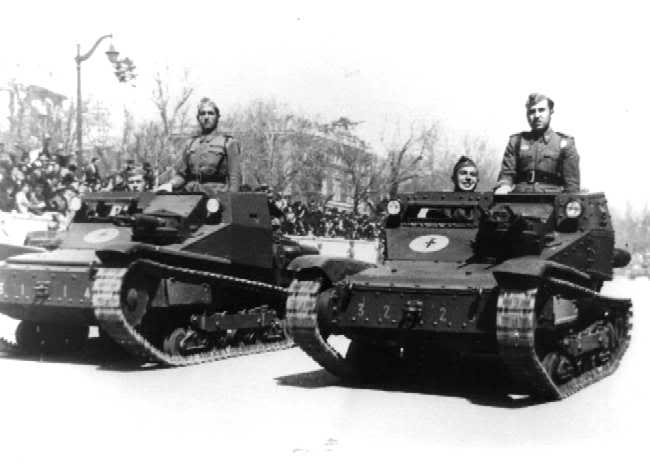
The ineffectiveness of the Italian Carro Veloce (Fast Tank) CV33 and CV35 tanks was rapidly identified. The CV33 was nothing more than a tankette, its armour was totally inadequate against infantry anti-tank weapons and the crew (of 2 men) suffered from the lack of spare parts. Other drawbacks were its slow speed (despite its light weight the CV never reached more than 45km/h), the fact that the starter mechanism was placed outside the vehicle. Due to its small size and vulnerability, Italian soldiers dubbed the CV33 the “sardine box” or “iron casket”
With regard to tank warfare, the Russian tanks often proved to be to well armoured for the light anti-tank weapons initially provided to Pohjan Pohjat, although the Bofors 37mm proved to be generally effective when correctly positioned and used. The deadly effectiveness of the Bofors 76mm AA gun in an anti-tank role was however emphasized and as a direct result, from 1937 on the Finnish Army made a major effort to build up the numbers of 76mm anti-tank guns in service with Infantry and Panssaari units in Finland. The ineffectiveness of the Italian CV33 and CV35 tanks was rapidly identified, with similar criticisms made of the German-supplied Panzerkampfwagen I’s. They were too lightly armoured and their machineguns were ineffective against enemy tanks, which could engage them at ranges where they were immune to the machine guns of the Panzer I and the Italian CV’s.
The Bofors 37mm-equipped LT34’s and Vickers 6-ton tanks were reported as being far more effective, as were the captured Russian tanks, although again, the armour was soon identified as being too light and other design and reliability deficiencies were also highlighted. The importance of command tanks and of armoured carriers for supporting infantry and logistical supplies was also stressed (Pohjan Pohjat improvised a number of armoured carriers for infantry from captured Soviet armoured cars and tanks. Regarding logistics, Pohjan Pohjat rapidly pieced together logistics columns to support the tank units – after initial experiences running out of fuel, Eversti Hans Kalm, Pohjan Pohjat’s commanding officer, would integrate logistics units into the armoured units, carrying up to a weeks worth of fuel, ammunition and food within the fighting units. There were many more such lessons taken back to Finland over the four years that the Finnish volunteer unit spent in Spain, each of them of value.
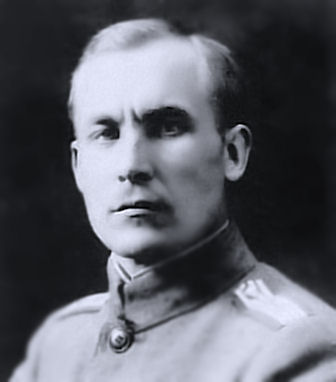
Eversti Hans Kalm, Pohjan Pohjat’s charismatic commanding officer and in the Winter War, CO of the 22nd Panssaaridivisoona
Among these lessons were the strategic locating of armour plate on the tank itself – extra armour on the front of the tank increased survivability while thinner armour could be used elsewhere. Sloped armour also added protection, while using welded armour was preferable to riveted or bolted armour (when the tank was hit, rivets and bolts had a tendency to break and ricochet around inside the hull to the detriment of the crew). Face-hardened steel also gave the crews (and the tank) an advantage. Good radio communication both between tanks, and between the tanks and supporting infantry, artillery and anti-tank guns was an essential to success. The importance of close-coordination between all arms. Leading from the front, where commanders were on top of the current tactical situation at all times. Speed of movement and flexibility in decision making. And much much more.
Pohjan Pohjat reports also emphasized the importance of using armour for flanking attacks rather than frontal assaults, emphasizing the war of maneuver and the need for armour, infantry, artillery and close air support to operate as a well-coordinated whole in order to gain the greatest effect whilst minimalizing casualties. In this, the importance of the Spanish Civil War experience of Pohjan Pohjat cannot be understated, providing the Finnish Army as it did with valuable insights into the art of war and into their equipment, weapons and tactics at both the small and large unit level. For the Finnish Army, the Spanish Civil War was a crucible in which tactical experimentation, existing and new weapons and improved training methods were forged into a new and far stronger alloy, an impenetrable shield on which the sword of the Red Army would shatter so disastrously in 1939/1940.
The Panzerkampfwagen II
In 1934, delays in the design and production of the Panzer III and Panzer IV medium tanks (covered next) were becoming apparent. The Panzer II came about in a German Ordnance Department requirement enacted in 1934, this time proposing a 10-ton light tank development with 20mm cannon and 7.92mm machine gun armament. As was the case in developing the Panzer I, it became common practice for the new Germany, now wholly under Hitler, to skirt the rules of the Versailles Treaty and develop its systems of war under various peaceful disguises such as farm equipment. As such, this new light tank design fell under the designation of “Landwirtschaftlicher Schlepper 100” (or “LaS 100”) under the guise that it was a farm tractor.
Designs for a stopgap tank were solicited from Krupp, MAN, Henschel, and Daimler-Benz. The final design was based on the Panzer I, but larger, and with a turret mounting a 20 mm anti-tank gun. The Panzer II was designed before the experience of the Spanish Civil War of 1936-39 showed that shell-proof armor was required for tanks to survive on a modern battlefield. Prior to that, armor was designed to stop only machine gun fire and high explosive shell fragments. The Panzer II A, B, and C had 14 mm of slightly sloped homogenous steel armor on the sides, front, and back, with 10 mm of armor on the top and bottom. Many IIC were given increased armor in the front. Starting with the D model, the front armor was increased to 30 mm. The Model F had 35 mm front armour and 20 mm side armor. This amount of armor could be penetrated by a towed antitank weapons, such as the Soviet 45mm and French canon de 25 and canon de 47. The Panzer II was around 50% heavier than the I and added a 20 mm Solothurn cannon as main armament as well as increasing maximum armour to 30 mm. Production began in 1935, but it took another eighteen months for the first combat-ready tank to be delivered. By July 1937, the Panzer II was cleared and ready for production.
Most tank versions of the Panzer II were armed with a 2 cm KwK 30 L/55 autocannon. Some later versions used the similar 2 cm KwK 38 L/55. This autocannon was based on the 2 cm FlaK 30 anti-aircraft gun, and was capable of firing at a rate of 600 rounds per minute (280 rounds per minute sustained) from 10-round magazines. A total of 180 shells were carried. The Panzer II also had a 7.92 mm Maschinengewehr 34 machine gun mounted coaxially with the main gun. All production versions of the Panzer II were fitted with a 140 PS, gasoline-fuelled six-cylinder Maybach HL 62 TRM engine and ZF transmissions. Models A, B, and C had a top speed of 40 km/h (25 mph). Models D and E had a torsion bar suspension and a better transmission, giving a top road speed of 55 km/h (33 mph) but the cross country speed was much lower than previous models, so the Model F reverted to the previous leaf spring type suspension. All versions had a range of 200 km (120 mi).
The Panzer II had a crew of three men. The driver sat in the forward hull. The commander sat in a seat in the turret, and was responsible for aiming and firing the guns, while a loader/radio operator stood on the floor of the tank under the turret. Production began in 1935, but it took another eighteen months for the first combat-ready tank to be delivered. Some 1,856 were manufactured between 1935 and 1943 and by 1939, some 1,226 Panzer IIs were in use. While larger, better-armed and better-armoured than the Panzer I, the Panzer II was still a light training tank that could also be used in a reconnaissance or policing role as well as providing priceless training to tank crews. Underpowered, under-armored and lightly armed, the Panzer II experienced its hardships particularly against anti-tank weaponry at close ranges. Nevertheless, war was on the horizon so time was of the essence and the more lethal Panzer IIIs and Panzer IVs were still being developed and would not be mass-produced in time for the coming battles.
According to some sources, the Panzer II was also sent to Spain from 1937, where it proved more capable against infantry than the Panzer I, but no better when faced with capable anti-tank guns or other tanks. However, no Panzer II’s were seen in Spain by the Finnish volunteers of Pohjan Pohjat.
The Finnish Army expressed interest in the Panzer II and indeed, in 1937 a small team evaluated the tank in Germany with a view to a possible purchase (as they evaluated other tanks from other countries). However, their assessment was that the tank was best suited to be used in a reconnaissance role and while it was comparable to other light tanks such as the Soviet T-26 and the French R-35 or H-35 (or indeed the Finnish Army’s own Vickers 6-ton or Czech-manufactured LT34 tanks), the 20mm gun was too light to be effective. In light of early experience in the Spanish Civil War, the Panzer II’s armour was also seen as being too thin and not offering any protection against anything other than rifle and machinegun bullets and shell fragments. However, all of this was a moot point as the Finnish team was advised that all Panzer II’s being built were going straight to the German Army and an export sale to the Finns would not be considered. The Finn’s thus saw no point in pursuing the matter further and no further approaches to the Germans were made with regard to this tank. At the time, with Czechoslovakia supplying Finland with tanks, no need was seen to attempt to push harder with the Germans.
The Panzerkampfwagen III
Shortly after the Panzer I was conceived as a light training tank, the Army Weapons Department drew up plans for a medium tank with a maximum weight of 24,000 kilograms (53,000 lb) and a top speed of 35 kilometres per hour (21.75 mph) based on specifications laid down by Heinz Guderain. It was intended as the main tank of the German Panzer divisions, capable of engaging and destroying opposing tank forces. At the time (1934), it was widely held that tanks would be used in two ways; supporting infantry against other infantry and in direct combat against other tanks and lighter vehicles. It was the infantry, in prepared defences and equipped with anti-tank guns, that presented the biggest threat to armour. Tanks designed to operate with friendly infantry against the enemy generally carried more armour and were heavier. A separate class, known as cruisers or mediums, were intended to exploit gaps in the enemy lines where opposition had been removed, moving through and attacking the enemy’s unprotected lines of communication and the rear areas. These designs were lighter and faster.
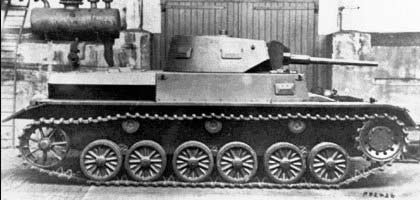
The Krupp MKA prototype for the Pz.III series. This was not adopted,but features from it were later used in the Pz.IV.
The Pz III was built to this lighter standard, and was intended to be paired with the Panzer IV which would handle the infantry tank role. Daimler-Benz, Krupp, MAN, and Rheinmetall all produced prototypes for the Pz III. Testing of these took place in 1936 and 1937, leading to the Daimler-Benz design being chosen for production. The first Panzer III model, the Ausführung A. (Ausf. A), came off the assembly line in May 1937. Ten, two of which were unarmed, were produced in that year. Mass production of the Ausf. F version began in 1939, but early production was limited and numbers produced were small in the period with which we are concerned (up to 1940):
- Panzerkampfwagen III Ausführung A – 1936 – 10 produced
- Panzerkampfwagen III Ausführung B – 1937 – 10 produced
- Panzerkampfwagen III Ausführung C – 1937/38 – 15 produced
- Panzerkampfwagen III Ausführung D – 1938/40 – 25 + 5 produced
- Panzerkampfwagen III Ausführung E – 1939/40 – 96 produced
- Panzerkampfwagen III Ausführung F – 1940 – 450 produced
Thus, as we can see from the above numbers, in the years in which Finland was building up their armoured forces, the Panzerkampfwagen III was very much a prototype with changes constantly being made. All early versions were unsuitable for large-scale production and each new model was an improved version of the previous one. Full production did not really start until 1939, at which time there was no appetite for exports. It would be December 1938 before production commenced in earnest with the Ausf. E series.
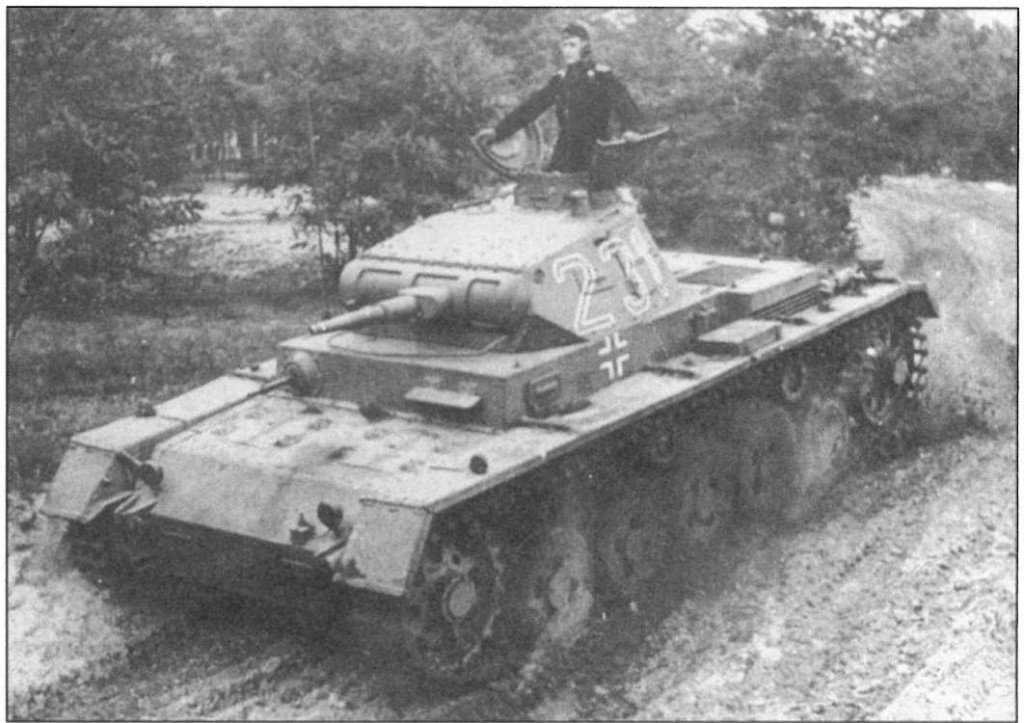
The Pz.III Ausf. A – had five medium-size road wheels and was armed with a 3.7cm L/45 gun and co-axial mg – 10 were built.
Much of the early development work on the Panzer III was a quest for a suitable suspension. Several varieties of leaf-spring suspensions were tried on the Ausf. A through Ausf. D before the torsion-bar suspension of the Ausf. E was standardized. The Panzer III, along with the Soviet KV heavy tank, was one of the first tanks to use this suspension design. A distinct feature of the Panzer III, influenced by British Vickers tanks (1924), was the three-man turret. This meant that the commander was not distracted with another role in the tank (eg as gunner or loader) and could fully concentrate on maintaining awareness of the situation and directing the tank. As we have already seen, most tanks of this time did not have this capability, providing the Panzer III with a potential combat advantage.
For example the French Somua S-35 had a one-man turret crew, while the original Soviet T-34 had a two-man turret. The practical importance of this feature is signified by the fact that not only all the further German tank designs inherited it, but also later into the war, most of the Allied tanks’ designs either quickly switched to the three-man turret, or were abandoned as obsolete. The Panzer III also had no turret basket, merely a foot rest platform for the gunner. The Panxer II was to be operated by the crew of five men, with commander, gunner and loader in the turret and the driver and radio operator in the hull front. The communication between crewmembers was through the use of intercom system. The Panzer III was the first of German Panzers to be equipped with intercom system for in-tank communications.
The Panzer III design was made up of four sections – hull, turret, and front superstructure with the opening for the turret and rear superstructure with the engine deck. Each section was of a welded construction and all four were bolted together. The hull was divided into two main compartments divided by a bulkhead. The front compartment housed the gearbox and steering mechanism and the rear one both the fighting and engine compartment. Basic hull, turret, superstructure and crew layout remained unchanged throughout the production life of the Panzer III series.
The early versions of the Panzer III, the Ausf. A through C, had 15 millimetres (0.59 in) of homogeneous steel armor on all sides with 10 millimetres (0.39 in) on the top and 5 millimetres (0.20 in) on the bottom. This was quickly determined to be insufficient, and was upgraded to 30 millimetres (1.18 in) on the front, sides and rear in the Ausf. D, E, F, and G models, with the H model having a second 30-millimetre (1.18 in) layer of face-hardened steel applied to the front and rear hull. The Ausf. J model had a solid 50-millimetre (1.97 in) plate on the front and rear, while the Ausf. J¹, L, and the M models had an additional layer of 20 millimetres (0.79 in) of armor on the front hull and turret. This additional frontal armor gave the Panzer III frontal protection from most British and Soviet anti-tank guns at all but close ranges. The sides were still vulnerable to many enemy weapons, including anti-tank rifles at close ranges.
The Panzer III was intended to fight other tanks. In the initial design stage a 50-millimetre cannon was specified. However, the infantry at the time were being equipped with the 37-millimetre (1.46 in) PaK 36, and it was thought that, in the interest of standardization, the tanks should carry the same armament. As a compromise, the turret ring was made large enough to accommodate a 50-millimetre cannon should a future upgrade be required (this single decision would later assure the Panzer III a prolonged life in the German Army). The Ausf. A to early Ausf. F were equipped with a 3.7 cm KwK 36 L/45, which proved adequate during the campaigns of 1939 and 1940. All early models up to and including the Ausf. F had two 7.92-millimetre (0.31 in) Maschinengewehr 34 machine guns mounted coaxially with the main gun, and a similar weapon in a hull mount.
The Panzer III Ausf. A through C were powered by a 250 PS (184 kW), 12-cylinder Maybach HL 108 TR engine, giving a top speed of 32 km/h (20 mph) and a range of 150 km (93 mi). All later models were powered by the 300 PS (221 kW), 12-cylinder Maybach HL 120 TRM engine. Top speed varied, depending on the transmission and weight, but was around 40 km/h (25 mph). The range was generally around 155 km (96 mi).
In the Polish and French campaigns, the Panzer III formed only a small part of the German armored forces. Only a few hundred Ausf. A through F were available in these campaigns, most armed with the 37-millimetre (1.46 in) gun. They were the best medium tank available to the Germans and outclassed in both firepower and armor most of their opponents, such as the Polish 7TP, French R-35 and H-35 light tanks and the Soviet T-26 light tank and BT cavalry tanks
Relations between the Finnish Army and the German Army through the 1930’s were generally good, if not close. The “Jaeger” officers who held many of the higher positions in the Finnish Army remembered the help given to Finland by the Germans in her fight for independence. There were ongoing ties at a professional level and Finnish requests for information, usually made informally, were almost always accommodated. Thus, German officers such as Guderain were aware of Finland’s ongoing efforts in building up their own armoured forces and of course, von Seeckt’s ongoing presence in Finland up until his untimely death also facilitated ongoing contacts. The Finns were thus well informed on the Panzer III design and construction project and had the opportunity to closely examine all the various models. The Finns did not however regard the Panzer III as in any way superior to their own Patria M/38 Sotavaunut, although they did make note of various design features incorporated into the different German prototypes as they were built.
The Panzerkampfwagen IV
The Panzer IV was the brainchild of German general and armored warfare theorist General Heinz Guderian. In concept, it was designed as an infantry support tank and intended to be used against enemy anti-tank guns and fortifications. Ideally, each tank battalion in a panzer division was to have three medium companies of Panzer IIIs and one heavy company of Panzer IVs. On 11 January 1934, the German army wrote the specifications for a “medium tractor”, and issued them to a number of defense companies.
The Panzer IV would be armed with a short-barreled 75-millimetre (2.95 in) howitzer as its main gun, with a weight limit of 24 tonnes (26.46 short tons). Development was carried out under the name Begleitwagen (“accompanying vehicle”), or BW, to disguise its actual purpose, given that Germany was still theoretically bound by the Treaty of Versailles. MAN, Krupp, and Rheinmetall-Borsig each developed prototypes, with Krupp’s being selected for further development.
The prototype required a crew of five men; the hull contained the engine bay to the rear, with the driver and radio operator, who doubled as the hull machine gunner, seated at the front-left and front-right, respectively. In the turret, the tank commander sat beneath his roof hatch, while the gunner was situated to the left of the gun breech and the loader to the right. The turret was offset 66.5 mm (2.62 in) to the left of the chassis center line, while the engine was moved 152.4 mm (6.00 in) to the right. This allowed the torque shaft to clear the rotary base junction, which provided electrical power to turn the turret, while connecting to the transmission box mounted in the hull between the driver and radio operator. Due to the asymmetric layout, the right side of the tank contained the bulk of its stowage volume, which was taken up by ready-use ammunition lockers. Production began in 1936.
- Panzerkampfwagen IV Ausführung A – 1937 – 35 produced
- Panzerkampfwagen IV Ausführung B – 1938 – 42 produced
- Panzerkampfwagen IV Ausführung C – 1938/39 – 140 produced
- Panzerkampfwagen IV Ausführung D – 1939/40 – 248 produced
The Panzer IV was originally intended to be used only on a limited scale, so initially Krupp was its sole manufacturer. Prior to the Polish campaign, only 217 Panzer IVs were produced.
The first mass-produced version of the Panzer IV was the Ausführung A in 1936. It was powered by Maybach’s HL 108TR, producing 250 PS (183.87 kW), and used the SGR 75 transmission with five forward gears and one reverse, achieving a maximum road speed of 31 kilometres per hour (19.26 mph. Main armamentwas the Kampfwagenkanone 37 L/24 (KwK 37 L/24) 75 mm tank gun, which was a low-velocity gun mainly designed to fire high-explosive shells. Against armored targets, firing the Panzergranate (armor-piercing shell) at 430 metres per second (1,410 ft/s) the KwK 37 could penetrate 43 millimetres (1.69 in), inclined at 30 degrees, at ranges of up to 700 metres (2,300 ft). A 7.92 mm (0.31 in) MG 34 machine gun was mounted coaxially with the main gun in the turret, while a second machine gun of the same type was mounted in the front plate of the hull. The Ausf. A was protected by 14.5 mm of steel armor on the front plate of the chassis, and 20 mm on the turret. This was only capable of stopping artillery fragments, small-arms fire, and light anti-tank projectiles.
The Ausf. B included the replacement of the original engine with the more powerful 300 PS (220.65 kW) Maybach HL 120TR, and the transmission with the new SSG 75 transmission, with six forward gears and one reverse gear. Despite a weight increase to 16 t (18 short tons), this improved the tank’s speed to 39 kilometres per hour (24 mph). The glacis plate was augmented to a maximum thickness of 30 millimetres (1.18 in), and the hull-mounted machine gun was replaced by a covered pistol port. The Ausf. C saw the turret armor increased to 30 mm (1.18 in), which brought the tank’s weight to 18.14 t (20.00 short tons). The Ausf. D reintroduced the hull machine gun and changed the turret’s internal gun mantlet to an external one. Again, protection was upgraded, this time by increasing side armor to 20 mm.
As with the Panzer II, the Finns were well informed on the Panzer IV design and construction project and had the opportunity to closely examine the early models. However, the Panzer IV was designed as an infantry support tank and this was of interest – particularly as this was a tank model the Finns had decided to exchew on the basis of cost. The Finnish Army could only afford one primary tank design (although they would end up with two, as we will see, although both would fill the same role). Given the large numbers of tanks in service with the Red Army, and their knowledge, such as it was, of Red Army doctrine and Tukhachevsky’s “deep operations” theory, the Finns had decided to concentrate on the “battle tank” capable of effectively fighting other tanks. Thus, while the Finns were interested in the Panzer IV, it was not a design they were interested in from a purchasing viewpoint, although again, they did make note of various design features incorporated into the different German prototypes as they were built.
Summary
The Finnish military had ongoing links to Germany through the 1930’s, some open, such as the employment of von Seekt as a Guest Lecturer, some more in the nature of “back-channel” unofficial links. Regardless, there were officers within the Finnish military who were well aware of the details of the German military buildup and whose job it was in some cases to track the development and availability of German military equipment. The Finns were well aware of the German armoured vehicle experiments and at different stages had evaluated most of the equipment and weapons the Germans used. While the Finns expressed interest in procuring weapons of various types from the Germans on a number of occasions, the pressures of German rearmament requirements meant that the Germans were rarely interested (or able) to sell to the Finns the weapons that they were interested in.
Tanks were just another of these items, and although the Finns were interested in the Panzer III and IV’s in particular, they never did acquire any German tanks over the course of the Winter War – the German Army’s demands were seemingly limitless while exports were limited. In the end, from the mid 1930’s through to October 1938, the main source of tanks for the Finnish Army would be Czechoslovakia. Finnish military procurement plans for the nacent Panssaaridivissoona took a severe blow in October 1938 when Czechoslovakia as a source of supply was eliminated as France and Britain acceded to Hitler’s demands. Finland, well aware of Czechoslovakia’s military-industrial capabilities, did its small best to influence events. However, it is not even certain that the Finn’s attempts to enlighten the French and British leaders responsible ever reached their ears. Indeed, it was the events of October 1938 that sparked Finland into a series of emergency measures intended to increase the country’s military capabilities almost regardless of cost. And it was these moves that, in all likeliehood, ensured that Finland had the military capability to take on the Red Army over 1939-1940 and prevail, albeit at heavy cost.
The loss of the Czechoslovakian military and industrial assets would come back to bite Britain and France in 1940 as France fell to the German onslaught. In September 1939, when Germany attacked Poland and went to war with France and Britain, German Panzer forces consisted of roughly 3,500 tanks:
- 1,445 Panzer I tanks
- 1,226 Panzer II tanks
- 98 Panzer III tanks
- 211 Panzer IV tanks
- 215 Command Tanks of various models
- 244 Czech Pz35(t) tanks
- 153 Czech Pz38(t) tanks
Indeed, the scarcity of the Panzer III and IV’s makes it seem questionable as to whether an attack on France would have gone ahead without the additional tanks Germany had taken over from the Czechoslovak armed forces – the 400 odd Pz35(t) and Pz38(t) tanks made up a significant proportion of the German tank force used against the French and British in 1940. By then however, Finnish interest was a moot point as Finland was itself fighting for survival against the Soviet onslaught – without any German tanks.
Return to Table of Contents
Previous: French Tanks of the Interwar Decades
Next: Italian Tanks of the Interwar Decades
 Copyright secured by Digiprove © 2014 Alternative Finland
Copyright secured by Digiprove © 2014 Alternative Finland


